2021 annual report
Kelowna, British Columbia, Canada
For the year ended December 31, 2021

city of kelowna
2021 annual report for the year ended december 31, 2021
The Annual Report is produced by the Communications and Financial Services departments of the City of Kelowna, in cooperation with all civic departments and agencies.
Kelowna, British Columbia, Canada
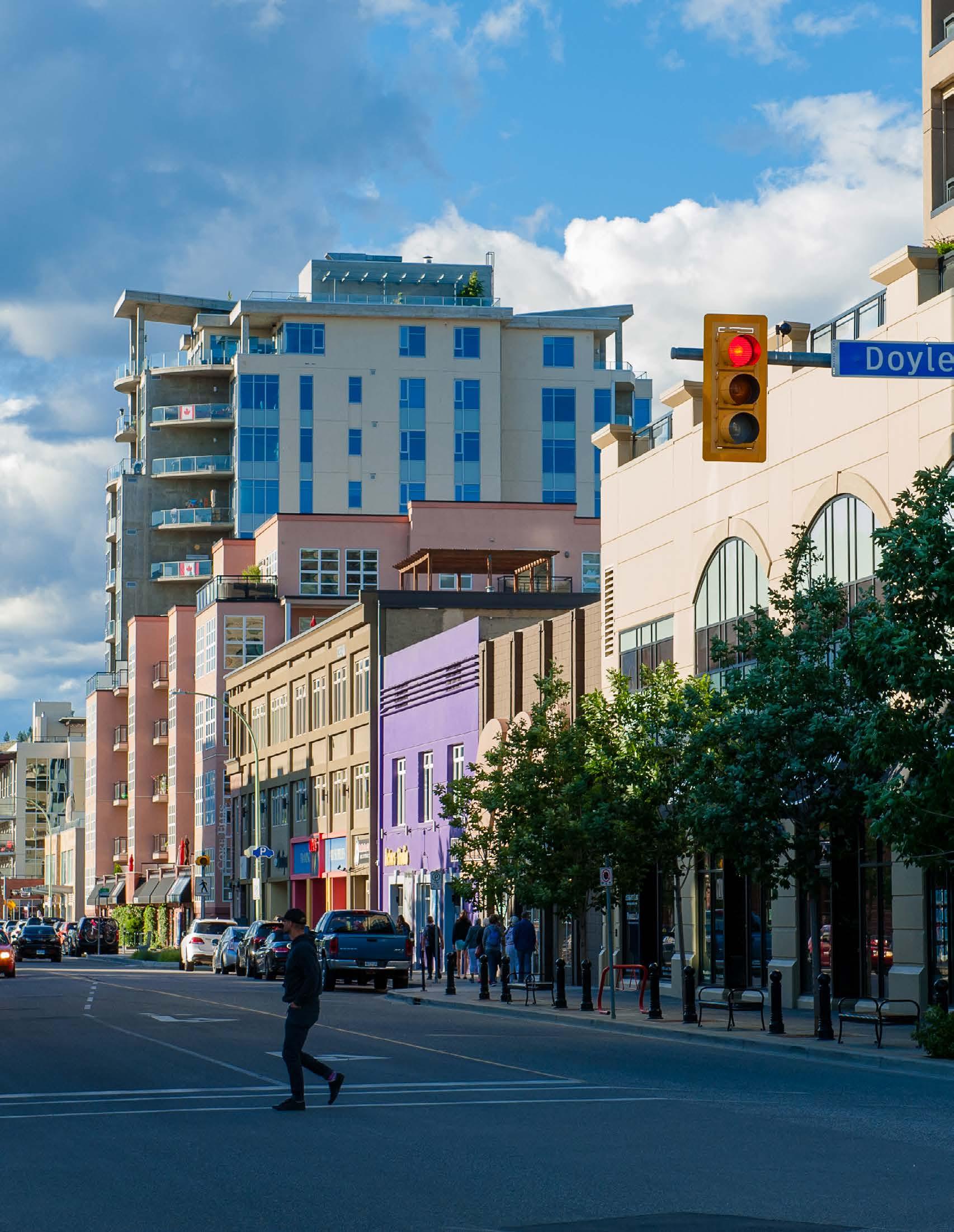
introduction A Message from the Mayor 4 A Message from the City Manager 6 Our Community 9 Mayor & Council 10 Our Organization & Organizational Chart 11 Financial Strategy 12 Civic & Community Award Winners 14 Awards & Recognition 15 council priorities Council Priorities 2019 – 2022 17 2021: From Resilience to Momentum 18 Community Safety 20 Social & Inclusive 21 Transportation & Mobility 23 Vibrant Neighbourhoods 24 Economic Resiliency 26 Environmental Protection 29 corporate priorities Financial Management, Clear Direction, People 31 financial information Index to Financial Statements Financial Services 33 Provision of Services & Support for Growth 33 City Reserves 34 Development Cost Charges 35 Financial Management Strategies 37 Top 10 Principal Corporate Taxpayers 38 Permissive Tax Exemptions 39 Revitalization Tax Exemptions & Heritage Building Tax Exemptions 43 Consolidated Financial Statements Report from the Divisional Director, Financial Services 44 Independent Auditor’s Report 46 Consolidated Statement of Financial Position 48 Consolidated Statement of Operations and Accumulated Surplus 49 Consolidated Statement of Changes in Net Financial Assets 50 Consolidated Statement of Cash Flows 51 Notes to the Consolidated Financial Statements 52 Schedule 1 – Tangible Capital Assets 70 Schedule 2 – Segmented Information 72 Schedule 3 – Long Term Debt 76 Schedule 4 – COVID-19 Safe Restart Grant for Local Governments 79 statistical review Statistical Review for the Years of 2017 – 2021 80 table of contents
a message from the mayor
We’ve gone through a lot the past two years and I’m sure we will have many challenges to navigate as we move forward, but we also have a lot to be optimistic about. Our collective vision—developed through Imagine Kelowna—will be more important than ever. Building community connections and creating a caring, smart, inclusive city that puts people first will be our way forward.
As we lean into our community’s vision—one that encourages curiosity and creativity, and where everyone does their part to seize opportunities for improvement—we are reassured by the fact that confidence in our city has never been greater. We are seeing record breaking investment and, with some of the strongest growth in the country, there is a clear signal that people want to live and do business in Kelowna—and we are more than ready to take advantage of our opportunities.
To shape this growth in a way that aligns with our community values and respects the natural wonders that contribute to our identity, a key focus in 2021 was completing the new Official Community Plan and Transportation Master Plan. These plans, working alongside others such as the Regional Transportation Plan, Community Climate Action Plan, Cultural Facilities Master Plan, and Healthy City Strategy, are the building blocks to our city’s continued prosperity. Strong integrated planning lays the foundation to not only be able to respond effectively to our community’s challenges, but also use them as an opportunity to innovate, and become a better city because of them.
As co-chair of the BC Urban Mayors’ Caucus, I can tell you we have made excellent progress turning advocacy into action with the provincial and federal governments on four critical issues facing our communities: mental health, substance use and treatment; affordable housing; public transit; and the development of a new fiscal relationship with both levels of government.

City of Kelowna 2021 Annual Report 4
This along with our diverse economy, thoughtful policy development and enviable quality of life will see us emerge from the last two years stronger in so many ways. But it will take all of us pulling in the same direction on things like climate action and community safety, two of our community’s most pressing priorities.
Building community connections and helping ensure Kelowna reaches its full potential begins with Truth and Reconciliation. Many of us are just beginning to understand what we didn’t know, or chose not to know, about our history. We need to take the steps necessary to reconcile our country’s past with a new relationship with First Nations in the Okanagan.
As we embark on the work ahead, it will be a period of positive transformative change for our city. I encourage our citizens to get involved by learning more about the Council Priorities 2019–2022 and visiting Get Involved Kelowna to find timely public input opportunities and help shape our city of the future.

5 A message from the Mayor
Mayor Colin Basran City of Kelowna
a message from the city manager
Each year the Annual Report provides our citizens and other stakeholders with detailed information about the City’s operating and financial activities for the fiscal year. It provides a permanent public record of the dollars spent, and results achieved across our various departments. It keeps our citizens informed and involved, while holding us accountable for ensuring the financial integrity of the organization and efficient delivery of services that touch the day-today lives of our citizens.
The ability to be flexible and nimble is an important aspect of any successful organization. However, responsible financial management is grounded in having a strong vision and clear set of priorities. They are the guideposts that drive decision-making and enable organizations to strategically and efficiently embrace opportunity, tackle challenges and deliver on promises.

Our city’s vision to 2040, Imagine Kelowna, was created by our community, for our community. It is built on four key principles of being responsible, smarter, collaborative and connected, and it outlines 14 goals to help us thrive in the face of unprecedented growth and change, and unexpected bumps—such as a global pandemic—along the way.
When a crisis hits, it’s more important than ever to pay close attention to our values, vision and goals. In a time of uncertainty, they will always reveal what is most important and where attention and resources need to focus. They underpin an organization’s ability to be resilient and responsive, which helps ensure recovery is swift and the organization ends up stronger because of it.
The following pages outline the incredible achievements that were made over the past year, despite the various obstacles and challenges— proof that our community’s vision and values are leading us in the right direction. We have become more technologically adept, more agile and we have adapted and diversified services to meet demand and improve quality of life.
City of Kelowna 2021 Annual Report 6
I want to commend our staff for their many long hours and dedication to innovation over the past year to better serve our residents. Your passion for public service and commitment to our community’s shared vision and influencing positive change is building a city of the future. As we round the corner on the current four-year council term, I would also like to acknowledge the work of our current Council and the continuous advancement of the 2019–2022 council priorities through unprecedented times. Council’s bold decisions this term have set up our community for success and ensured that we are taking actions that serve our community as a whole.
Finally, I thank our citizens, community partners and service providers. The past year has confirmed what we learned through the Imagine Kelowna vision process: to flourish in the future, we need to be agile, resilient, and unafraid to do things differently and, as we grow, we need to continue to take care of one another and protect the environment that sustains us. That is what we did throughout 2021, and will continue to do, because Kelowna is more than just a beautiful city; it’s our home.
 Doug Gilchrist City Manager, Kelowna
Doug Gilchrist City Manager, Kelowna
7 A message from the City Manager
territory acknowledgement
We acknowledge that our community is located on the traditional, ancestral, unceded territory of the syilx/Okanagan people.

8
our community
Kelowna is located along the beautiful shores of Okanagan Lake, in the heart of the stunning Okanagan Valley. With a four-season lifestyle, the lake offers opportunities for boating, swimming and fishing, while nearby mountains attract hikers, skiers and outdoor enthusiasts. From scenic golf courses to bustling urban centres with delectable restaurants, awardwinning wineries and breweries, local shopping, museums, live entertainment and cultural festivals, residents and visitors enjoy it all in Kelowna.
Nearly all citizens (92 per cent) rate the quality of life in Kelowna as good or very good thanks to recreational opportunities, safety, its accessible location, job opportunities, stunning landscape and the great weather.
The technology sector has seen us dubbed as the Silicon Valley of the north and is a pillar of the regional economy. Dynamic tourism, post-secondary education, construction, real estate, healthcare and deep-rooted agriculture sectors are drivers of our economy.
As a highly desirable place to live, Kelowna remains one of Canada’s fastest growing cities. By 2040, we expect a growth of more than 45,000 new residents who will call Kelowna home.
citizen survey
The most recent (2020) City of Kelowna Citizen Survey gauged public satisfaction with municipal programs and services. According to the survey:
9 Our Community
mayor & council
The City of Kelowna is governed by an elected Mayor and eight Councillors for a four-year term (2018–2022). Led by Mayor Colin Basran, Kelowna City Council is committed to building on the momentum of past Councils and being open for opportunity through community engagement and partnerships. It is consistent and transparent in decisions, creating a favourable









environment for customer service, development and business in Kelowna. Council meets regularly and the public is welcome to attend any open meeting or provide feedback in writing via mail or email.
Learn more at kelowna.ca/council
City of Kelowna 2021 Annual Report 10
colin basran Mayor
gail given Councillor
mohini singh Councillor
maxine dehart Councillor
charlie hodge Councillor
luke stack Councillor
ryan donn Councillor
brad sieben Councillor loyal wooldridge Councillor
our organization
The organization is led by our dedicated City Manager, Mayor and Council. More than 1,000 employees deliver quality services to ensure our city is safe, vibrant and sustainable. Strong financial management allows us to provide core services to the citizens of Kelowna, introduce new amenities and maintain valuable infrastructure.
Council Priorities 2019–2022 identifies the strategic shifts, improvements and changes that are important to Council, the community and organization. Our annual Action Plan identifies the strategic and operational work required to deliver results on these priorities.
The annual Progress Report on Council Priorities 2019–2022, released each spring, is an interactive online report showing how the City is taking action and making progress,
demonstrating Council’s commitment to transparency and accountability.
The Financial Plan provides the most comprehensive view and plans for how we deliver the core services that residents rely on like emergency services, clean drinking water and roads.
Working together with the Annual Report to keep the public informed of City projects and progress, are the kelowna.ca website, City Views newsletter and a variety of social media channels designed to spark conversation and connections with our community. Citizens can also provide input and be involved on key projects through the City’s online engagement platform getinvolved.kelowna.ca. Engaged citizens help build strong neighbourhoodsz and create a city that is welcoming and inclusive.
organizational chart
11 Our Organization office of the city clerk Stephen Fleming City Clerk
kelowna residents city council city manager Doug Gilchrist partnerships & investments Derek Edstrom Divisional Director corporate & protective services Stu Leatherdale Divisional Director infrastructure Mac Logan General Manager corporate strategic services Carla Weaden Divisional Director planning & development services Ryan Smith Divisional Director kelowna international airport Sam Samaddar Airport Director active living & culture Jim Gabriel Divisional Director financial services Genelle Davidson Divisional Director
financial strategy: strength & stability
Sound financial strategy is the ability to acquire and manage a portfolio of financial and physical assets that meet the current and future needs of our community. Read more about our Financial Management Strategies on page 37.
financial strategy
• Assets – New
• Assets – Renew
• Debt
• Development Financing
financial principles
plans that influence financial decisions
• Sufficient
• Pragmatic
• Council Priorities
• Official Community Plan
• Imagine Kelowna vision
• Grants
• Operations
• Partnerships and Enterprise
• Property Taxation
• Flexible
• Transparent
• 10-year Capital Plan
• 2030 Infrastructure Plan
• 20-year Servicing Plan
• Reserves and Surplus Funds
• User Fees and Charges
• Balanced
• Community Trends Report
residents’ top 5 priorities for investment
budget revenues by type (%)
City of Kelowna 2021 Annual Report 12 Financial Strategy
ADDRESSING SOCIAL ISSUES IN THE COMMUNITY DRINKING WATER PROVIDING DIVERSE HOUSING OPTIONS FIRE AND POLICE SERVICES TRAFFIC FLOW MANAGEMENT
2021 FINANCIAL PLAN FINAL BUDGET VOLUME 3
SOURCE:
did you know?
City of Kelowna has a diverse portfolio of operations, some of which are run as self-funded business units that have no impact on property taxes (example: water utility, wastewater utility, parking services, and Kelowna International Airport). The City provides corporate services to these business units and uses internal allocations to recover these costs. This prevents these costs from being included in the annual property tax levy and allows the fees charged by the self-funded business units to encompass the full cost to deliver their service.
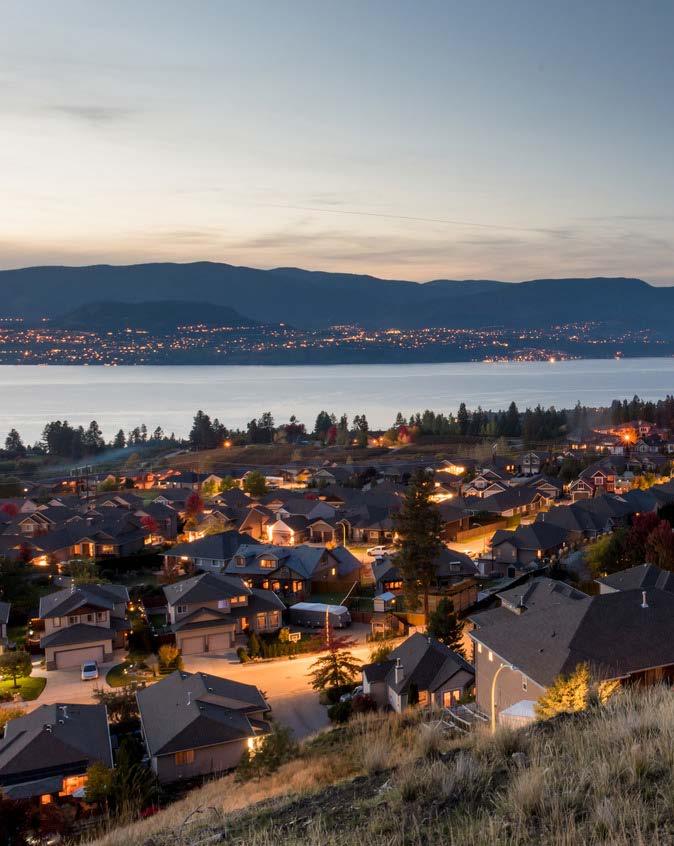
civic & community award winners
47th Annual Civic & Community Award Recipients
Honouring individuals and organizations for outstanding contributions and achievements in 2021 that directly benefited the community, making Kelowna a great place to live, work and play.
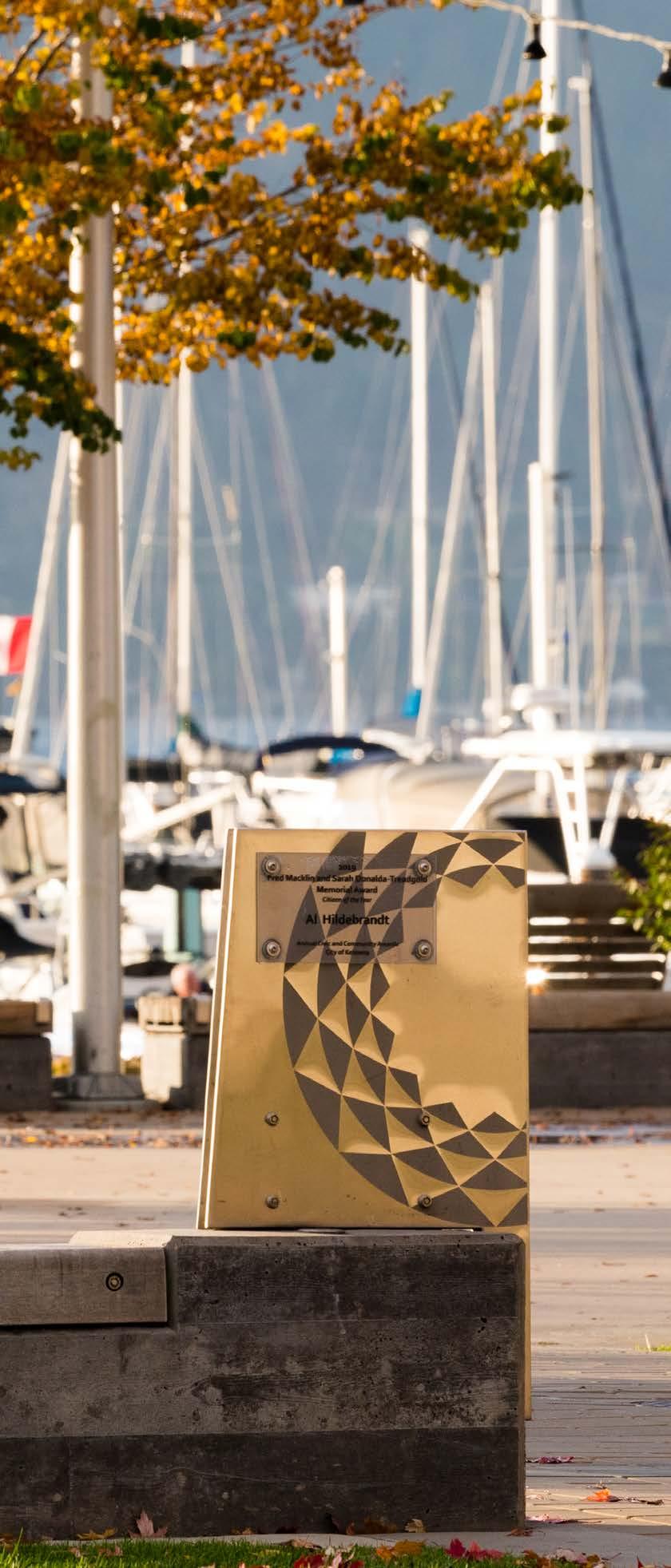
edna terbasket
Anita Tozer Memorial Award
lloyd nelson
Sarah Donalda Treadgold & Fred Macklin Memorial Award –Citizen of the Year
don dobson
Champion for the Environment Award
toyota kelowna
Corporate Community of the Year Award
canadian mental health association – kelowna
Central Okanagan Foundation –Volunteer Organization of the Year Award
david withler
Young Citizen of the Year Award
jennifer money
Honour in the Arts Award
dryden bennett
Teen Honour in the Arts Award
malindi elmore
Female Athlete of the Year Award
jerome blake
Male Athlete of the Year Award
tatum wade
Augie Ciancone Memorial Award –
Top High School Female Athlete
tie: everett schmuland & nathan loo
Augie Ciancone Memorial Award –
Top High School Male Athlete
kelowna secondary school owls boys
volleyball team
Bryan Couling Memorial Award – Athletic Team of the Year
mike sodaro
Bob Giordano Memorial Award – Volunteer Coach or Sport
Administrator of the Year
14
awards & recognition
The City of Kelowna received a number of awards and recognition in 2021 including:
government finance officers association
canadian award for financial reporting
2020 Annual Report
This is the 19th consecutive year the City has received the award recognizing excellence in governmental accounting and reporting.
government finance officers association

distinguished budget presentation award
2021 Financial Plan
This is the 20th consecutive year the City has received the highest form of recognition for governmental budgeting.
southern interior construction association (sica)
building award – civil
Kelowna Integrated Water Project – Phase 1
Emil Anderson Construction
southern interior construction association (sica)
building award – project of the year
Kelowna Integrated Water Project – Phase 1
Emil Anderson Construction
share the road cycling coalition
Bicycle Friendly Community Designation
Canadian Award for Financial Reporting
Presented to City of Kelowna
British Columbia
For its Annual Financial Report for the Year Ended
December 31, 2020
Executive Director/CEO

15 Awards & Recognition
Government Finance Officers Association
council priorities

16
council priorities 2019 – 2022
imagine kelowna: vision into action
Council Priorities 2019–2022 identifies the strategic shifts, improvements and changes that are important to Council, the community and organization. It is an open and accessible commitment to how we will advance the Imagine Kelowna vision within this Council’s term. It will focus the work we do to become the Kelowna residents told us they want to see. Reporting on its progress each year is part of Council’s commitment to working in a way that is citizen focused, balanced and embraces continuous improvement. The interactive progress report can be found at kelowna.ca/councilpriorities
breakdown of 2021 council priority action plan projects
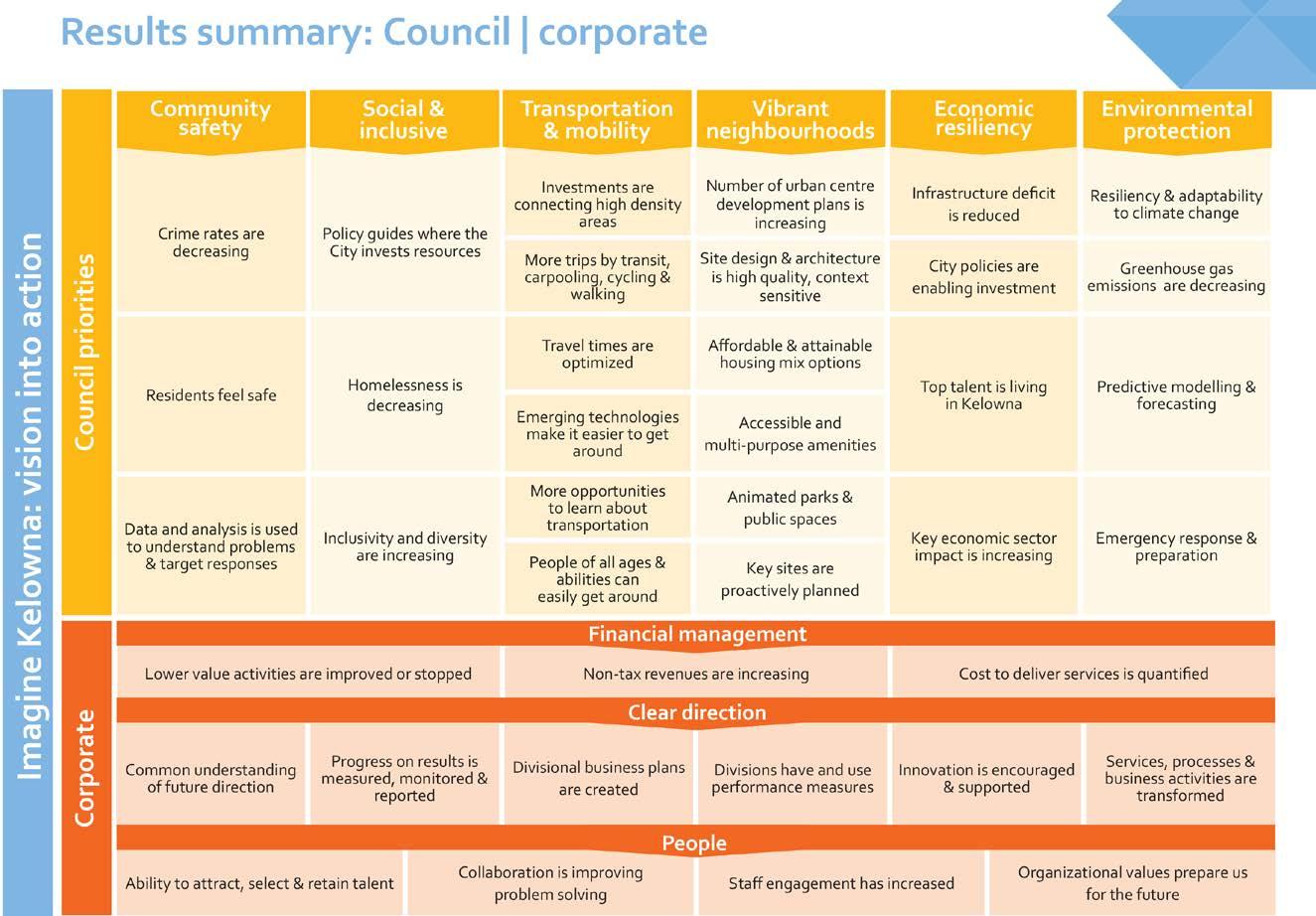
2021 progress results
• 29 results are trending in the right direction
• 5 results show no change or it is the first year that data is available
• 5 results are not trending in the right direction
Learn more at kelowna.ca/councilpriorities.
17 Council Priorities 2019–2022
SOURCE:ACTION PLAN 2021
2021: from resilience to momentum
setting the stage for an inclusive, prosperous and sustainable future
While 2020 demonstrated our community’s resilience, 2021 was a story of response and, despite a global economic downturn, substantial progress. Alongside the completion of pivotal strategies and the realization of recordsetting milestones, key economic indicators are showing Kelowna is heading into 2022 with momentum—and living up to its promise of becoming a City of the Future.
Between 2016 and 2021, our city’s population increased 13.5 per cent, making it the fastest growing city in B.C. while having the third-fastest growing downtown in Canada (behind Montreal and Halifax). For the first time, building permit values exceeded $1 billion and Kelowna International Airport (YLW), one of the largest economic drivers in the Southern Interior, continued to be one of the top 10 busiest airports in the country, and was one of the fastest recovering airports in Canada.
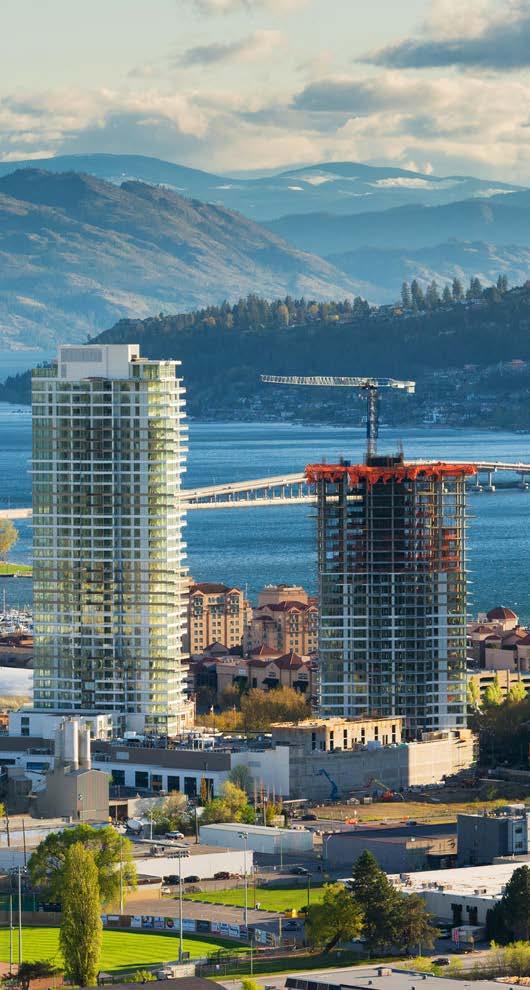
Though restrictions and the biggest wave of the pandemic yet continued to touch many aspects of our lives, 2021 offered an opportunity to innovate, optimize and streamline, revealing new—better and more efficient—ways of doing things. New economic opportunities were generated through a focused approach to community partnerships, and key foundational plans to shape our city’s growth and respond to complex social and community safety issues were pushed over the finish line.
Of the many projects and initiatives completed in 2021, arguably none could be more important than the 2040 Official Community Plan (OCP) and 2040 Transportation Master Plan (TMP)
The OCP sets a strategic course for the next 20 years as to how our city should grow, prioritizing areas, decisions and policies that our citizens have told us they want to focus on through Imagine Kelowna and OCP engagement opportunities. The 2040 TMP sets the direction for a vibrant city where people and places are conveniently connected by diverse transportation options. Working together, the two plans will help achieve the vibrant, sustainable and inclusive future residents envisioned through the creation of our city’s Imagine Kelowna community vision.
Throughout the year, staff also worked diligently to advance City of Kelowna’s Action Plan 2021, which identifies the organization’s most notable strategic and operational work for the year. This included developing Kelowna’s first Community Safety Plan, a comprehensive, systems-based, five-year action plan to generate shared ownership, vision and action among government ministries and community organizations that contribute to community safety.
As these and many more projects throughout 2021 taught us, flexibility, adaptability, innovation and a shared vision are the cornerstones of a vibrant, resilient city. It is through this that we generate valuable new ideas and approaches to support our community’s vision and turn progress into the results that create the Kelowna we want to live in and leave for the next generation.
To learn more and view the interactive 2021 progress report on Council priorities 2019–2022, visit kelowna.ca/councilpriorities
18 City
of Kelowna 2021 Annual Report
an historic agreement Paving the Way for Important Improvements
As a result of months of discussions throughout 2021, the Okanagan Indian Band, District of Lake Country and City of Kelowna reached an agreement on a Memorandum of Understanding (MOU) that will pave the way toward building important health, safety and infrastructure improvements, including completion of the Okanagan Rail Trail. The historic agreement will provide many improvements, not only to residents and businesses in the area but have positive cultural and economic spin-offs for the entire region.
a time to learn and listen
National Day for Truth and Reconciliation
On September 30, 2021, City of Kelowna marked the first annual National Day for Truth and Reconciliation with ceremonial acknowledgments of the new relationship emerging between Canada and Indigenous Peoples—one based on the recognition of rights, respect, co-operation and partnership. City flags were flown at half-mast to remember the lost Indigenous children who died in residential institutions and to express condolence and respect to survivors and local First Nations.
meet me on bernard
Creating Vibrant Urban Spaces while Stimulating Economic & Social Recovery
The City, in partnership with the Downtown Kelowna Association and Tourism Kelowna, launched Meet Me on Bernard, opening Bernard Avenue to pedestrian-only traffic over the summer. The open-streets initiative allowed 23 businesses to extend patios to create more space, and also featured seven parklets designed and created collaboratively by more than 20 local landscaping and architect firms, daily and nightly performances from local artists and buskers, and numerous art installations woven through the four blocks of Bernard.

19 2021 in Review
community safety
goal: crime is reduced and residents feel safe
Community safety remains a top priority for Kelowna citizens and City Council. The City and its partners are using data and analysis to better understand the root causes of crime and our specific local problems so we can deliver targeted responses. What contributes to a family in a suburban neighbourhood feeling safe might be different than that of a university student travelling from downtown to campus at night.
As crime is intrinsically linked to societal conditions, the safety and well-being of a neighbourhood is achieved when we all pull together on a clear set of goals. Throughout 2021, the City worked with many partners to develop Kelowna’s first collaborative Community Safety Plan. Generating shared ownership, vision and action among government ministries, community partners and Kelowna residents, it is a comprehensive, systems-based, five-year action plan designed to deliver community safety strategies and outcomes, and build governance structures for ongoing coordination and integration among systems leaders.
Alongside the Community Safety Plan, Kelowna RCMP launched its 2021–2024 Strategic Plan, which focuses on achieving measurable differences in public safety outcomes, while maintaining other critically important services including: frontline policing, traffic enforcement, drug enforcement and youth engagement. It also significantly expanded its Community Safety Unit to increase visibility and responsiveness in the downtown area, Rutland, and parks, as well as enhanced collaboration with cross-sector partners in response to those who experience mental health and substance use issues.
additional highlights
• Supported the launch of Kelowna Community Court, an integrated court to more effectively address offenders concurrently experiencing mental health, substance use disorder and/or homelessness.
• Strengthened RCMP contract management practices, including establishing policing priorities and outcomes to enhance police visibility, responsiveness, efficiency and effectiveness.
• Enhanced services at the Rutland Community Policing Office and restructured the Crime Prevention Branch.
• Expanded the Safety Education Ambassador Program to increase the safety of our local parks, beaches, and waterfronts from the May long weekend to the September long weekend.
• Received funding from the Union of B.C. Municipalities (UBCM) for an update of the Community Wildfire Resiliency Plan, which involves multiple departments and intended to guide wildfire risk reduction activities.
• Completed a comprehensive review of crime prevention programs and services, including bylaw services.
• Received Airport Health accreditation from Airports Council International recognizing YLW’s commitment to prioritizing health and safety.
City of Kelowna 2021 Annual Report 20
social & inclusive
goal: fewer people will experience homelessness and inclusion and diversity are increasing
The City is playing an increasingly active role to address social issues—as many cities are. Our community puts people first and welcomes people from all backgrounds. We all benefit when everyone in the community has access to economic, recreational and social opportunities.
As a Built for Zero Canada community, progress was made in 2021 towards gaining a better understanding of how people flow in and out of homelessness, which will support the data-driven goal of optimizing the local homeless serving system through continuous improvement practices. Key achievements included the development of a coordinated governance model, access system, and a road map for achieving integrated data system among community partners.
The City received a $3.2 million grant from the Union of BC Municipalities (UBCM) Strengthening Communities’ Services Program funded by the Government of Canada and the Province of BC to support implementation of the City’s Outdoor Sheltering Strategy. The strategy is designed to support unsheltered people experiencing homelessness and address related community impacts. A Community Emergency Shelter Strategy is currently in development and will provide a system-wide approach for the delivery of shelter services, which is founded on the four core principles of choice, healing, community and safety.
Through partnerships with BC Housing and the Journey Home Society, 49 units of housing with supports opened in 2021. A total of 318 units of housing with supports have been added since the onset of the Journey Home Strategy, surpassing the five-year goal. Although significant investments have been made by all levels of government to address homelessness in Kelowna, the City and its partners still have work to do to decrease the number of people experiencing homelessness in our community.
additional highlights
• Engaged Urban Matters to develop a Youth Services Framework that will guide the creation of programs and services designed to build resilience in youth.
• Implemented mandatory training for all front-line employees at YLW on how to provide assistance to people with disabilities.
• Added additional infrastructure at YLW to help improve accessibility for all guests. This included a new relief area for service animals, visually contrasting stair tread to the second level of the Air Terminal Building and visually contrasting colours to the front curb pillars.
• PEOPLE Peer Navigators and Capacity Building Program, in its second year of the three year $691K Health Canada funded project, demonstrated strong results. Local capacity to train and host peers has significantly increased with two cohorts of Peer Navigator graduates placed in seven different local social serving organizations to meaningfully improve experiences of people with lived and living experience of substance use and other vulnerable circumstances.
21 Social & Inclusive
Community Safety (9%) Social & Inclusive (10%) Transportation & Mobility (20%) Vibrant Neighbourhoods (40%) Economic resiliency (8%) Environmental protection (13%) 6 9 6 28 14 7
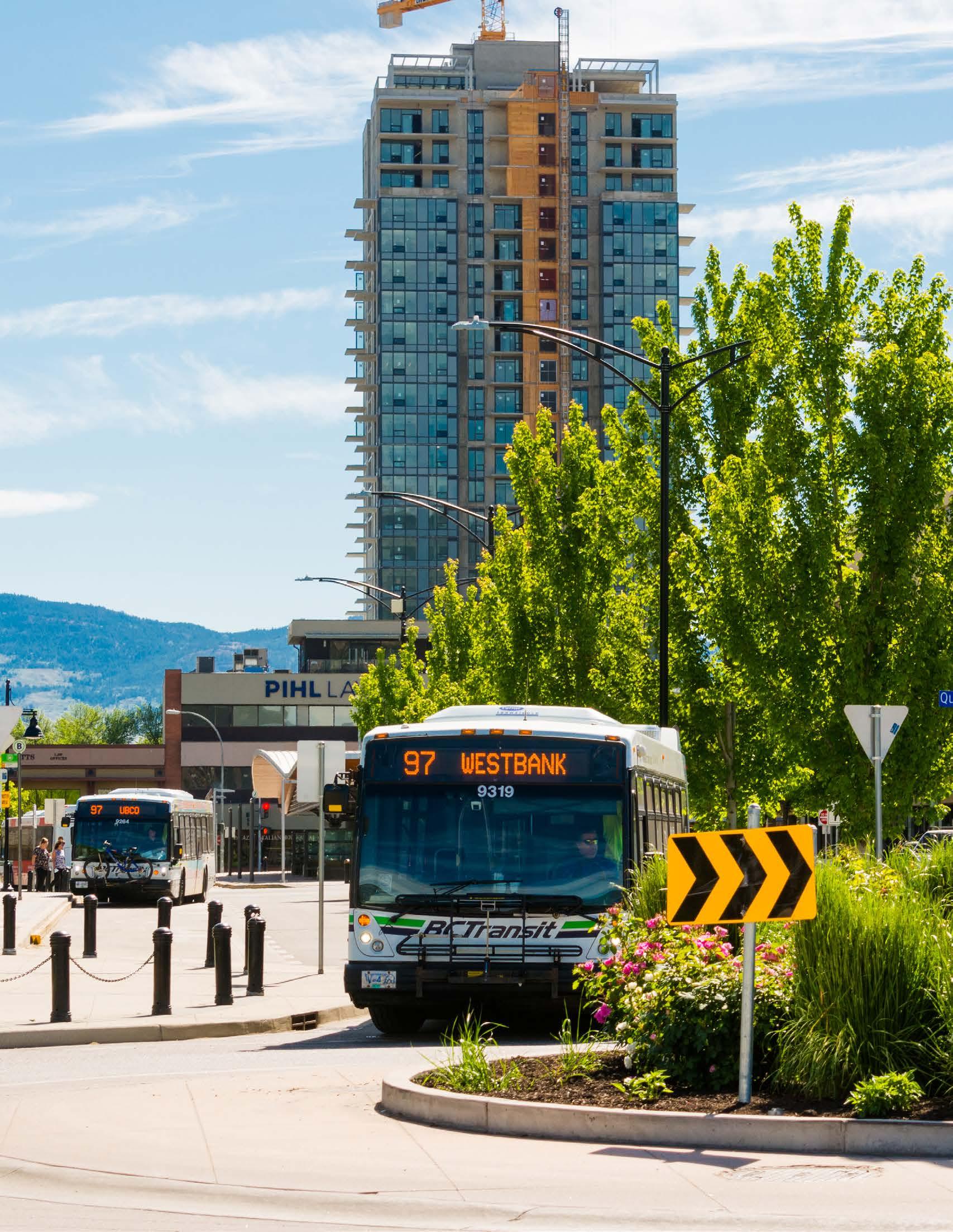
22
transportation & mobility
goal: fewer trips are made by car and solutions are innovative
Following a four-year planning process and more than 12,000 community inputs from citizens and stakeholders, 2021 marked the completion of the 2040 Transportation Master Plan (TMP).
The pivotal long-term, citywide plan sets the direction for a vibrant city where people and places are conveniently connected by diverse transportation options.
Outlining improvements that will help keep Kelowna moving, now and into the future, it includes 100 recommended actions that will help us maintain and renew our existing infrastructure, create fast and reliable transit, improve road connections, develop comfortable bicycle routes, create walkable neighbourhoods, and help people use and enjoy new ways of getting around.
Supporting the TMP goals to double transit ridership, quadruple the number of trips made by bicycle, and reduce the average distance each person drives by 20 per cent, in 2021, the City opened the latest phase of the Ethel Street Active Transportation Corridor (ATC) between Rose and Raymer avenues, providing residents with access to a dedicated pedestrian and bike route separate from vehicle traffic all the way from Cawston Avenue to Raymer Avenue.
The year also saw the introduction of shared e-scooter and e-bike programs, offering flexible, affordable and accessible mobility options to residents.
additional highlights
• Launched pilot artificial intelligence tool that automatically maps potholes.
• Received a $2.4 million provincial/federal government grant to extend the Houghton Road Active Transportation Corridor (ATC) from Rutland to the Okanagan Rail Trail.
• Widened Lakeshore Road bridge over Bellevue Creek to two lanes of vehicle traffic, buffered bike lanes in each direction and added a multi-use pathway.
• Completed Taxiway D rehabilitation at YLW.
• Launched a new transit orientation video that aims to help youth and older adults feel confident taking public transit. The video is part of a suite of public education materials.
• Repaved Taxiway E and finalized design for Air Terminal Building expansion
Transportation & Mobility 23
vibrant neighbourhoods
goal: affordable housing and higher density neighbourhoods
By 2040, Kelowna’s population is expected to grow by more than 45,000 citizens. This growth will bring both opportunities and challenges, and strategic planning is essential to ensure Kelowna can continue to be prosperous, vibrant and resilient in the years to come. Following a multi-year planning process alongside the development of the 2040 Transportation Master Plan (TMP), the new 2040 Official Community Plan (OCP), a high-level policy document that guides how and where our city grows, was completed in 2021.
Developed with participation from more than 2,000 citizens and stakeholders, the new OCP will shape how our city looks and feels. It includes updated land uses, mapping and policies to reflect the community’s vision and clearly signal where development will be prioritized and supported with infrastructure and amenities. The OCP provides a framework for Council by addressing issues such as housing, transportation, infrastructure, parks, economic development and the natural and social environment.
In support of a strong OCP, recreation, arts and culture play key roles in vibrant neighbourhoods, as do special events and activities that connect the community. In 2021, the City—in partnership with the Downtown Kelowna Association and Tourism Kelowna—launched Meet Me on Bernard, an open-streets initiative designed to generate more vibrant urban spaces while stimulating economic and social recovery. Returning for a second season in 2022, the popular attraction will again feature extended patios, free community programming, musical entertainment, public art and unique animations woven throughout the four blocks of Bernard leading to the waterfront.
Inclusive, vibrant neighbourhoods also know the value of sport in creating strong, connected communities. Throughout 2021, the City developed a provincially endorsed Quality Sport Framework to guide local sport organizations in creating experiences that are safe, inclusive and meaningful for all participants at every stage of their sport pathway. Sport is also a major economic driver and in July the City, in partnership with over 20 partners including Tourism Kelowna, School District 23, and PacificSport Okanagan, celebrated winning the bid to host the 2026 BC Summer Games. The games are expected to generate over $2 million in economic impact for Kelowna and the Central Okanagan.

• Finalized the long-term land lease of 350 Doyle Avenue and worked with arts organizations on a Creative Hub Feasibility Study to understand the opportunities in the proposed 6,000 square feet of new cultural space.
• Conducted a programming review of Kelowna Community Theatre to identify and evaluate different programming models and ways to improve audience experiences. Significant renovations were made to the lobby and washrooms.
• Opened Phase 3 of Glenmore Recreation Park featuring two sport fields and an off-leash dog park.
• Completed final phase of Rutland Centennial Park featuring a basketball court, ping pong tables, new landscaping, and lighting.
• Completed public engagement on designs for Tallgrass and Ballou neighbourhood parks in Tower Ranch and Glenmore respectively.
• Unveiled designs and construction schedule for the future of City Park.
• Improved the Cook Road boat launch, including parking lot upgrades.
• Conducted community engagement and consultation (including two “Get Eventive” weekends) as part of the planning and development of a Strategic Event Plan and future “signature” event for Kelowna.
• Endorsed a two-year pilot period for vehicle access on Knox Mountain Drive with input from more than 8,000 survey respondents.
City of
2021 Annual Report 24
Kelowna
additional highlights

25 Vibrant Neighbourhoods ESTIMATED PER CAPITA INVESTED ARTS, CULTURE & HERITAGE BUILDING PERMITS ISSUED MULTI-FAMILY UNITS 835 SINGLE DETACHED UNITS NEWPURPOSE-BUILT RENTAL UNITS OCCUPIED 716 $24.96 2,116
economic resiliency
goal: the infrastructure deficit is reduced, and kelowna is investment friendly
Economic resiliency is the ability to adapt to changing market conditions and recover and reconstruct after a shock. While the effects of COVID-19 provided some positive outcomes, such as the development of new technologies and services, reduced economic activity and revenue loss were a challenge for many organizations locally and beyond.
Building in economic resiliency strengthens our capacity to adapt and thrive in the face of challenge, including emergencies like a global pandemic. Throughout 2021, we focused on business continuity planning for essential services such as roadways, water and wastewater; reducing infrastructure deficit; enhancing online service delivery; and continuing to nurture a culture of entrepreneurship and collaboration.
Economic resiliency also means making our city attractive to investors, a key component of our ability to weather,
bounce back from and thrive after a crisis. One of the strongest examples of economic resiliency in 2021 was YLW, one of the largest economic drivers in the Southern Interior. Serving more than 830,000 passengers in 2021, it was one of the fastest recovering airports in Canada, capturing 41 per cent of its 2019 passenger numbers (2,032,019). Increasing domestic flight destinations to 14, which is five more than it has ever had, it operated as one of the top 10 busiest airports in Canada in 2021.
2021 provided yet another year of strong growth in the city’s urban centres, demonstrating the market’s confidence in the city’s direction.
Maintaining quality infrastructure, delivering a skilled workforce and high level of livability, and streamlining processes to welcome investment that supports our community vision, remain keys to Kelowna’s continued prosperity.
City of Kelowna 2021 Annual Report 26
Grow vibrant urban centres & limit sprawl Build a fair and equitable community Nurture entrepreneurship Foster residentdriven solutions Protect land, water & air Protect agricultural land Preserve Okanagan Lake as a shared resource Support innovation Take action in the face of climate change Build healthy neighbourhoods for all Embrace transportation options Create great public spaces Provide opportunities for all Cultivate an engaging arts & culture scene
additional highlights
• Introduced a more streamlined new Business Licence System enabling residents to apply for and manage licences online.
• Completed a Central Okanagan Music Strategy to support the growth and sustainability of the local music industry. Among the highlights are recommendations for a purposebuilt venue and affordable and accessible spaces for music education and practice.
• Developed market sounding and expressions of interest for destination retail and hotel development at YLW to drive community and economic benefits.
• Launched the new Recovery and Sustainability Grant Program, a one-time funding initiative to support nonprofit organizations in the sport, event and cultural sectors who continue to be significantly impacted by lost earned revenue due to the COVID-19 pandemic.
• YLW received $3.1 million in operational grants from Federal Airport Relief Fund program, and $0.7 million in operational support from the BC Provincial COVID-19 Airport Relief Fund to help mitigate the financial impact of COVID-19.
• Streamlined development permit and public hearing processes.

27 Economic Resiliency

28
environmental protection
goal: adaptable in the face of climate change
The scientific community warns that global warming needs to be halted within the next few decades to reduce the risks of extreme and irreversible climate change. Kelowna is already experiencing floods, fires and drought and changes in climate, creating a new normal every year. From disruptions in food security and pricing, water availability and energy supplies to local infrastructure and personal property damage, climate change is no longer a future trend, but instead requires our community to respond today.
In 2021, the Okanagan experienced a four-month pronounced drought, compounded by a nine-day extreme temperature period referred to as the Heat Dome, the unease of constant threat of fire, critically low creek flows, and a low runoff year resulting in very low water levels in Okanagan Lake. The result was a number of stresses from a social, financial and environmental perspective.
As a municipality we need to be a leader in environmental protection and addressing climate change, because the investments we make today will impact the quality of life of our future generations. While the City cannot control the occurrence of extreme weather events, we continue to integrate climate adaptation into policies and projects, and ensure our community is prepared for and resilient to the impacts of climate change.
Our strategic direction for how our community will grow, commute, interact and protect natural assets is intricately related to how we will reduce greenhouse gas (GHG) emissions and adapt to anticipated climate changes and those changes we are already experiencing. In September 2021, Council endorsed the Community Electric Vehicle and E-Bike Strategy which recommends actions we can take to achieve the vision that Kelowna is a city where charging an EV and riding an E-bike is easy, convenient and affordable. The City also pledged to convert 10 per cent of the light duty corporate fleet to Electric Vehicles (EVs) by 2023 and we received funding from PluginBC to complete a new “Green Fleet Strategy” as well as an assessment of electrical infrastructure needs to support EV charging over the next 10 years. The report estimates that the City can reduce fleet greenhouse gas emissions by 49 per cent by 2031, based on the current availability of EV technologies.
Local governments are uniquely positioned to influence the shift towards a low carbon lifestyle and to respond to the impacts of climate change. However, it will take all of us working together to protect our environment and affect change.
additional highlights
• In 2021, the City completed the Official Community Plan and Transportation Master Plan, highlighting targets, policies and actions for the reduction GHG emissions.
• The City offered top-up rebates for electric vehicle chargers in multi-family buildings and electric heat pumps that complement provincial rebates.
• Continued early adoption of Energy Step Code by moving to Step 3 for Part 9 Buildings, which requires all new buildings to be 20 per cent more efficient than the base BC Building Code.
• Maintained Airport Carbon Accreditation Level 1 at YLW.
• Transitioned fire fighting foam used at YLW to a fluorinefree foam.
• Transitioned irrigation of the wastewater treatment plant property from the potable water supply to reclaimed water from the treatment process. The system will save energy, fertilizer and reduce effluent going into the lake.
• Awarded $9 million Environmental Quality Grant from the Government of Canada and Province of BC for the Kelowna septic system elimination and sewer connection project, which includes eliminating over 600 aging septic fields from Central Rutland, Rio/Rialto, and a creek crossing for future servicing of the Hall Road connection area.
29 Environmental Protection
corporate priorities
City of Kelowna’s leadership team has identified the following three corporate priorities during the 2019–2022 Council term. A list of projects and initiatives that will advance the results in each of these areas is published each January at kelowna.ca/actionplan. Citizens can view a detailed progress report on action plans—including 2021 council and corporate priorities—at kelowna.ca/councilpriorities.

30
financial management clear direction
desired results
• Lower value activities are being improved or stopped
• Non-tax revenues are increasing
• The cost to deliver services is quantified summary:
In 2021, 29 projects aligned with our goal to ensure that every touchpoint with citizens and our customers is of good value and achieving its intended outcome. Non-tax revenues increased in 2021 with the largest increase coming from fees and charges ($24 million) driven by increased development, air travel and parking, as well as a one-time additional payment of $5.4 million from the Federal Community Works Fund used to fund eligible infrastructure projects. Government contributions also increased in comparison to 2020 with grants being received for: COVID-19 pandemic relief at the Kelowna International Airport, unsheltered populations and related community impacts, and provincial gaming revenue.
people
desired results
• The ability to attract, select and retain the right people is improving
• Collaboration within the organization, and with external stakeholders, is improving problem solving
• Staff engagement has increased
• Organizational values have shifted to prepare us for the future
summary:
Collaboration has been identified as both a corporate priority and as an organizational value. As such, it is receiving more intentional focus and action both with internal partners and external partners. In 2021, we formed a culture committee to bring this and other priorities and values to life across the organization. Corporate Communications and Human Resources led and completed work to align a number of business practices, tools and policies to the refreshed values. We introduced Principles of Conduct Guidelines and updated our training and development strategy as well as culture and values content in touchpoints across the organization. At the end of the year, 95 per cent of managers had introduced organizational culture content to 80 per cent or more of their staff. The full-time employee turnover rate was 10.3 per cent in 2021 which is a significant increase over the 2020 rate of 5.6 per cent. The higher rate is consistent with 2021 labour market trends. However, the turnover with new full-time employees with less than one year of service dropped in 2021, signaling improvements in the selection of the right candidates.
desired results:
• Common understanding of where the organization is going in the future
• Progress on Council and corporate results is measured, monitored and reported
• Divisional/departmental plans show how we are advancing the Council and corporate results and outline key operational initiatives
• Divisions and departments have meaningful performance measures that are reviewed regularly
• Innovation is encouraged and supported throughout the organization
• Services, processes and business activities are being transformed
summary:
The model of Council and corporate priorities and more consistent divisional-level planning, paired with our organizational vision and values introduced in 2021, has helped evolve our culture and deepen a common understanding of where the organization is going. In 2021, we continued to shift more services, including business licensing, online and promoted increased use of the automated chatbot to answer customer questions. A total of 6,916 business licenses (81 per cent ) were processed through the new system, 1,000 building permit applications were received online, and over 50 per cent of chatbot interactions took place outside regular business hours.
31 Corporate Priorities
financial information

City of Kelowna 2021 Annual Report 32
financial services
The City of Kelowna is committed to financial strength and stability. The City defines this as the ability to acquire and manage a portfolio of financial and physical assets that meet the current and future needs of our community. This commitment to excellence was recognized again by the Government Finance Officers Association. In 2021 and for the nineteenth year in a row, the City was awarded the Canadian Award for Financial Reporting and for the twentieth year, the Distinguished Budget Presentation Award.
canadian award for financial reporting
The Government Finance Officers Association of the United States and Canada (GFOA) awarded a Canadian Award for Financial Reporting to the City of Kelowna for its annual financial report for the fiscal year ended December 31, 2020. The Canadian Award for Financial Reporting program was established to encourage municipal governments throughout Canada to publish high quality financial reports and to provide peer recognition and technical guidance for officials preparing these reports.
In order to be awarded a Canadian Award for Financial Reporting, a government unit must publish an easily readable and efficiently organized annual financial report, whose contents conform to program standards. Such reports should go beyond the minimum requirements of generally accepted accounting principles and demonstrate an effort to clearly communicate the municipal government’s financial picture, enhance an understanding of financial reporting by municipal governments, and address user needs.
A Canadian Award for Financial Reporting is valid for a period of one year only. We believe our current report continues to conform to the Canadian Award for Financial Reporting program requirements, and we are submitting it to the GFOA.
provision of services & support for growth
In December of 2020, Council approved the 2021 Financial Plan – Preliminary volume with a tax increase of 4.04 per cent, followed by the addition of the 2021 Carryover budget in March 2021. As the COVID-19 pandemic had already been present in our community since early 2020, staff were able to plan for 2021 with the knowledge that there would be financial impacts. However, the impacts from the pandemic were numerous and conditions changed frequently as the year progressed.
The COVID-19 pandemic was a health crisis without precedent in our recent history. The pandemic continued to create challenges for Kelowna as the public health challenges impacted our community at large, as well as our City operations. In addition, British Columbia experienced a significant heat-dome, wildfires and flooding during 2021. The combined impacts of these events created supply chain challenges and significantly higher levels of inflation.
To recognize the complex financial challenges faced by our residents, the 2021 Financial Plan was used as a financial response as the City worked to maintain the essential services we provide, while also keeping taxation as low as possible. The 2021 Final Budget, as approved by Council in April of 2021, kept the tax increase at the same rate as the Preliminary Budget tax requirement of 4.04 per cent.
The City budgeted to collect a total of $274.9 million in taxation revenues, 57 per cent of which was retained for municipal purposes. The remaining 43 per cent is levied on behalf of other governments and agencies to provide funding for schools, the Regional District of Central Okanagan shared services, libraries, regional hospital, Kelowna business improvement areas, and for BC Assessment to cover the City’s share of costs associated with providing assessment information.
The City has historically relied on pay-as-you-go rather than debt financing for infrastructure needs wherever possible in achieving strategic servicing goals. Pay-as-you-go capital project funding represented 7.7 per cent of the 2021 taxation requirement. The service area with the highest cost with funding from municipal taxation is Community Safety, including RCMP, at 30.4 per cent, followed by the Fire Department at 14.3 per cent and Parks Services at 12.8 per cent.
Financial Information | Financial Services 33
5.0% Active Living & Cultural Services
3.1% Debt
2.2% Grants
2.0% Utility Services
30.4% Community Safety
4.7% Transit/Regional Services
5.2% Planning & Development Services
7.2% Building Services
12.8% Parks Services
13.1% Transportation Services
14.3% Fire Department
city reserves
City Council approved policy 384 Financial Reserves in July of 2021. Reserves form an integral component of the City’s budget and strategic financial plan to help ensure equity between current and future taxpayers. The City maintains reserves to achieve the following policy objectives:
• To acquire, replace and renew major capital assets;
• To ensure stable, predictable tax and utility levies;
• To minimize the financial impact of unusual and unexpected events including but not limited to law enforcement, weather events, insurance claims, tax assessment appeals, environmental hazards and other significant unexpected or emergent issues;
• To achieve long-term financial stability;
• To balance the costs of maintaining sufficient Reserve levels to current and future taxpayers;
• To fund asset retirement obligations;
• City reserves are established, maintained and used for specified purposes as mandated by statute, City bylaw or Council policy.
$139 $71 $54 $254 $267 $280 $310 $84 $88 $97 $116 $54 $106 $93 $82 $119 $137 2017 2018 2019 2020 2021 2017 2018 2019 2020 2021 $59 $65 $69 Breakdown of Municipal Tax for 2021 City of Kelowna 2021 Annual Report 34 Financial Information | City Reserves
Reserve for future General Natural Gas Statutory Wastewater Water Surplus Airport 0 $40 $80 $120 consolidated reserves & surplus millions long term debt millions
development cost charges
Development cost charges (DCCs) are fees that municipalities collect from new development to help pay the cost of infrastructure services that are needed for growth. Imposed by bylaw pursuant to the Local Government Act, the charges are intended to facilitate development by providing a method to fund capital projects related to roads, drainage, sewer, waterworks, and parkland.
The City’s DCC program supports community development and integrates with longer-term plans. Infrastructure requirements are based on the Official Community Plan that estimates a resulting population of 161,701 by the end of 2030. The 20-Year Servicing Plan and Financing Strategy provides the infrastructure requirements to 2030 along with the cost sharing for various projects. Cost sharing methodologies reflect the level of benefit to existing taxpayers and new growth. Charges are based on the demand placed on services by different residential types, commercial, industrial, and institutional growth.
The current plan, updated in February 2020 to include park development and linear park acquisition, reflects a total program cost of $993 million. The funding for the program is 66 per cent from Development, 29 per cent from City funds, and 5 per cent from senior levels of government. Arterial Roads maintain the largest share of the program at $518 million; followed by Park Development and Land Acquisition at $278 million, Wastewater Treatment at $88 million, Water Distribution at $64 million, and Wastewater Trunks at $45 million.
Local governments are permitted to temporarily lend available money from one DCC reserve fund to another. The money, along with appropriate interest, must be returned to the original reserve fund. For 2021, a deficit in Water Sector B reserve fund was covered from Water Sector A and a deficit in the Wastewater Treatment reserve was covered by Water Sector A and Roads Sector A reserve fund.

35 Financial
| Development Cost Charges
Information
municipal assist factor
The Local Government Act requires local governments to assist in the cost of growth-related infrastructure. The municipal assist factor is separate from costs allocated between growth and the existing users on the basis of benefit. The level of the assist, determined by City Council, reflects the community’s desire to encourage development by reducing the DCC rates by the level of assist adopted.
of Kelowna Municipal Assist Factor
major project expenditures in 2021
Parks Acquisition
$3.8 million – Parkland Acquisition at 3684 Lakeshore Road.
Parks Development
$1.8 million – Pandosy Waterfront Park, Rutland Centennial Park, and Ponds Community Park.
Roads
$2.5 million – Lakeshore 1 (Bridge, ATC, and Road) and Ethel Active Transportation Corridor (ATC).
Water
$250k – Skyline Pump Station – Electrical Building Upgrade.
Wastewater Trunks and Treatment
$800k – Water Street Force Main and Gyro Force Main.
future plans
Total 2022 program expenditures are projected at $37.4 million made up of the following major projects:
Parks Acquisition
$12.5 million – Parkland acquisition.
Parks Development
$13.3 million – DeHart Park, Pandosy Waterfront Park, Mission Recreation – Softball Diamonds, Mission Creek Linear Park and Ballou Park.
Roads
$6.4 million – South Perimeter Road, Hollywood Road, Stewart Road West, Houghton ATC and McCulloch Area Roads.
Water
$780k – Poplar Point to Dilworth Mountain Transmission Upgrade.
Wastewater Trunks and Treatment
$650k – Guy Street Lift Station Renewal.
Development Cost Charge Reserve Funds (thousands of dollars)
*Waivers are for Affordable Rental Housing Grants and are funded through taxation.
On April 18, 2016 Council approved the 2030 Infrastructure Plan, which identifies all the City’s infrastructure investment needs for the next 15 years (2016 – 2030).
City of
2021 Annual Report 36
Kelowna
Opening Transfers Closing Reductions/ Balance Receipts Interest Out Balance Waivers* Parks Land/ Development $ 21,344 $ 22,176 $ 473 $ 7,528 $ 36,465 $ 97 Roads 57,647 18,604 1,083 3,143 $74,191 78 Water 14,842 1,289 256 263 $16,124 7 Wastewater (10,079) 8,771 (115) 772 ($2,195) 38 Total $ 83,754 $ 50,840 $ 1,697 $ 11,706 $ 124,585 $ 220 City
Roads 15% Parks 8% Water 1% Wastewater 1%
financial management strategies
Principles and Strategies for Financial Strength and Stability have been adopted by Council establishing guidelines for how the City will acquire and manage a portfolio of financial and physical assets that meets the current and future needs of our community.
The 10 financial management strategies are:
assets – new
Expenditures for new assets will be prioritized based on social, economic and environmental factors and life cycle cost implications. Emergent opportunities will be evaluated against existing priorities. Investment in new assets should follow the long-term capital plan. The decision-making process for new asset investment will be documented, transparent and clearly communicated to Council, staff and the community.
assets – renew
The City will invest in existing infrastructure renewal in accordance with the long-term capital plan. Funding for asset renewal will be balanced against service levels and risk tolerance. Life cycle costs should be managed through preventative maintenance and renewal strategies.
debt
General Fund debt servicing costs will be maintained at or below a targeted level of annual taxation demand. The City’s debt capacity will be preserved by limiting the use of debt to fund only one-time major capital projects. If possible and when beneficial, debt will be paid down earlier. Financing for less than a five-year term will be completed through internal financing. Impacts on overall City debt levels from “self-funded” cost centres and Funds will be reviewed and understood.
development financing
Developers will pay their fair share for growth-related infrastructure through DCCs and other tools. Where appropriate, other funding can be used to provide additional capacity over and above the current OCP horizon. Taxation- funded DCC’s through grant programs may be used to encourage economic development and community projects.
grants
Grants will only be pursued for the City’s priority projects. Grant funding will not increase the scope of a project without Council endorsement. Annual project funding must be sufficient without conditional grants. Long-term financial planning will rely on unconditional grant opportunities only.
operations
All services, including new services, must be aligned with the City’s priorities and reviewed regularly. The full financial cost of service and staff requirements will be understood by Council and administration. Future changes in operating costs, including personnel resourcing requirements, will be considered in long-term capital and financial planning. Ongoing operating activities will only be funded through taxes, fees and charges.
partnerships and enterprise
The City will pragmatically partner with other entities to deliver community services and amenities. The City will explore access to new sources of capital and revenue streams. The City will leverage existing assets to attract private sector involvement. The City will leverage the expertise of outside partners. Services from partnerships will be reviewed regularly to ensure the needs of the City continue to be met. The City supports organizations within the community that enhance the quality of life.
property taxation
Property taxes will remain as stable as possible over time. Property taxes will be comparative with similar communities. Increases to property taxes will be balanced among assessment classes. Property tax information will be transparent and easy to understand. Property taxes will reflect the infrastructure, services and service levels that the community believes are important.
reserves and surplus funds
The purpose of each reserve will be documented and reviewed regularly. Ongoing operating requests will not be funded from reserves. Accumulated surplus will only be used as an emergency funding source.
user fees and charges
Everyone will pay a fair amount for the services they receive. Services will be reasonably accessible by all citizens. User fees will be transparent and easy to understand.
37 Financial Information | Financial Management Strategies
top 10 principal corporate taxpayers
City of Kelowna 2021 Annual Report 38 Financial Information | Top 10 Principal Corporate Taxpayers
2021 Legal Name Type of Property 1 Al Stober Construction Ltd Commercial Building 2 FortisBC Inc Electrical Utility 3 Orchard Park Shopping Centre Shopping Mall 4 Victor Projects Ltd Shopping Mall 5 McIntosh Properties Ltd Shopping Mall 6 Inland Natural Gas Co Ltd Gas Utility 7 Callahan Construction Company Ltd Multiple Types 8 3752 Investments Ltd Multiple Types 9 Midwest Ventures Ltd Multiple Types 10 RG Properties Ltd Shopping Mall 2020 Legal Name Type of Property 1 Orchard Park Shopping Centre Shopping Mall 2 FortisBC Inc Electrical Utility 3 Inland Natural Gas Co Ltd Gas Utility 4 Al Stober Construction Ltd Commercial Building 5 DHL No 48 Holdings Ltd Hotel & Convention Centre 6 McIntosh Properties Ltd Shopping Mall 7 RG Properties Ltd Shopping Mall 8 4231 Investments Ltd Shopping Mall 9 Tolko Industries Ltd Lumber Mill 10 Victor Projects Ltd Shopping Mall
Source: City of Kelowna Financial Services Department.
permissive tax exemptions
39 Financial Information | Permissive Tax Exemptions
Art Gallery, Museum, Heritage, Cultural Purpose Central Okanagan Heritage Society $7,352 Centre Culturel Francais De L’ Okanagan $3,724 German - Canadian Harmonie Club $5,983 Kelowna Art Gallery $105,189 Kelowna Canadian Italian Club $4,036 Kelowna Community Music Society $4,407 Kelowna Museums Society - Kelowna Centennial Museum $82,267 Kelowna Museums Society - Okanagan Military Museum $55,687 Kelowna Museums Society (Laurel Packing House) $44,094 Kelowna Visual and Performing Arts Centre Society $88,201 OCCA Communities Association $1,394 Okanagan Symphony Society $14,825 Roman Catholic Bishop of Nelson Pandosy Mission $2,821 Westbank First Nation $8 Athletic or Service Club Central Okanagan Land Trust $9,923 Central Okanagan Small Boat Association $27,530 East Kelowna Community Hall Association $2,414 H2O Adventure & Fitness Centre $219,904 Kelowna & District Fish & Game Club $4,748 Kelowna Badminton Club $8,365 Kelowna Cricket Club $475 Kelowna Curling Club $23,426 Kelowna Lawn Bowling Club $12,827 Kelowna Major Men’s Fastball Association $19,532 Kelowna Minor Fastball Society $1,912 Kelowna Outrigger Racing Canoe Club Association $22,109 Kelowna Riding Club $4,853 Kelowna United Football Club $299 Kelowna Yacht Club $8,750 Nature Trust of BC $47,472 Okanagan Gymnastic Centre $14,550 Okanagan Mission Community Hall Association $6,191 Rutland Park Society $8,839 Scouts Canada $10,339
City of Kelowna 2021 Annual Report 40 Financial Information | Permissive Tax Exemptions Charitable or Philanthropic BC Society for Prevention of Cruelty to Animals $13,729 BHF Building Healthy Families Society $2,052 Big Brothers Big Sisters of the Okanagan Society $3,736 Bridges to New Life Society $4,135 Canadian Mental Health Association $7,843 Central Okanagan Community Food Bank Society $22,393 Central Okanagan Emergency Shelter Society $4,505 Daycare Connection Childcare Society $906 Kalano Club of Kelowna $6,107 Kelowna & District S.H.A.R.E. Society $9,857 Kelowna & District Safety Council Society $3,000 Kelowna Centre for Spiritual Living Society $2,308 Kelowna Child Care Society $3,386 Kelowna Community Resources $21,379 Kelowna Gospel Mission Society $14,262 Kelowna Senior Citizens Society of BC $8,472 Kelowna Yoga House Society $8,765 Kelowna(#26) Royal Canadian Legion $5,780 KGH - Rutland Auxiliary Thrift Shop $9,522 Ki-Low-Na Friendship Society $21,175 MADAY Society for Seniors $2,907 National Society of Hope $5,083 New Opportunities for Women (NOW) Canada Society $2,890 Okanagan Boys & Girls Clubs $95,039 Okanagan Halfway House Society Inc $7,845 Okanagan Mental Health Services Society $1,825 Pathways Abilities Society $22,486 Reach Out Youth Counselling & Services Society $5,243 Resurrection Recovery Resource Society dba Freedom’s Door $14,840 Salvation Army Community Resource Centre $24,758 Society of St. Vincent De Paul of Central Okanagan $4,797 Starbright Children’s Development Centre Assoc. $28,653 The Bridge Youth & Family Services Society $8,296 Tourism Kelowna Society $13,879 Hospital Licenced Under Community Care Facility Act Canadian Cancer Society $19,736
41 Financial Information | Permissive Tax Exemptions
Capital News Centre $73,301 Prospera Place $257,029
Schools Aberdeen Hall Preparatory School Society $43,573 Immaculata Regional High School $67,766 Kelowna Christian Centre School $10,393 Kelowna Christian School $16,368 Lakeside School Kelowna $12,164 Lutheran Church - Private School $11,932 Okanagan Montessori Elementary $9,750 Seventh Day Adventist Church (Private School) $44,451 St. Joseph Elementary School $35,344 Studio9 Independent School of the Arts (Private School) $4,693
Worship
Resource Centre Society
$28,971 BC Assn of Seventh Day Adventist $1,829 C3 Church $4,235 Christ Evangelical Lutheran Church $6,625 Church of the Nazarene $4,215 Corpus Christi Roman Catholic Parish (formerly
$5,383 Dormition of the Mother of God (formerly Assumption Of Blessed Virgin Mary’s Parish) $5,402 Evangel Tabernacle Church $5,639 Faith Lutheran Church $5,932 First Baptist Church $7,628 First Lutheran Church of Kelowna $11,932 First Mennonite Church $6,178 First United Church $8,464 Glenmore Congregation of Jehovah’s Witnesses $6,366 Grace Baptist Church $13,110 Gurdwara Guru Amardas Darbar Sikh Society $3,758 Immaculate Conception Parish $8,825 Kelowna Bible Chapel $9,140 Kelowna Buddhist Society $5,969 Kelowna Christian Centre Church (School) $10,393 Kelowna Christian Reformed Church $8,391 Kelowna Congregation of Jehovah’s Witnesses $3,988 Kelowna Full Gospel Church $4,603
Partnering
Private
Public
Apostolic
(formerly New Life Vineyard Fellowship)
St. Theresa’s Parish)
City of Kelowna 2021 Annual Report 42 Financial Information | Permissive Tax Exemptions Kelowna Gospel Fellowship Church $7,040 Kelowna Tabernacle Congregation Church $1,358 Kelowna Trinity Baptist Church $30,329 Mennonite Brethren Churches (Willow Park Church) $9,489 Mennonite Brethren Churches (Metro Community Church) $6,550 Mission Creek Alliance Church $16,256 Mission Springs Church of God (formerly German Church of God Dominion of Canada) $3,771 New Apostolic Church $3,627 Okanagan Chinese Baptist Church $3,574 Okanagan Jewish Community Association $3,864 Okanagan Sikh Temple & Cultural Society $8,105 Providence Baptist Church $3,656 Ridgeview Evangelical Missionary Church $4,725 Rutland United Church $6,431 Salvation Army Community Church $10,331 Serbian Orthodox Par-Holy Proph St Ilija (Parish) $935 Seventh Day Adventist Church $23,241 Spring Valley Congregation of Jehovah’s Witnesses $7,234 St. Andrew’s Church $8,220 St. Charles Garnier Parish $1,950 St. David’s Presbyterian Church $8,704 St. Mary’s Anglican Church $941 St. Michaels Anglican Church $10,237 St. Peter & Paul Ukrainian Greek Orthodox Church $5,343 St. Pius X Parish $6,418 Synod of the Diocese of Kootenay $4,005 The BC Muslim Association $3,248 The Church of Jesus Christ of Latter-Day Saints $9,193 The Congregation of Bethel Church $5,675 The Embassy Church $4,225 The Union of Slavic Churches of Evangelical Christians $1,397 Truth Now Tabernacle United Pentecostal Church $1,628 Unitarian Fellowship of Kelowna Society $2,972 Total Municipal Portion of Permissive Tax Exemption $2,294,447
revitalization tax exemptions
43 Financial Information | Revitalization Tax Exemptions & Heritage Building Tax Exemptions Revitalization Tax Exemptions Tax Incentive Area #1 1775 Chapman Pl $29,657 269 Lawrence Ave $18,087 Tax Incentive Area #2 596 Leon Ave $4,186 552 – 554 Leon Ave $21,071 Tax Incentive Area #3 110 Highway 33 W $33,369 1350 St Paul St $9,840 1759 Highway 33 E $5,863 200 Nickel Rd $17,233 225 Rutland Rd S $31,099 460 Doyle Ave $94,095 Purpose-Built Rental Housing 1155 Brookside Ave $29,683 125 Dundas Rd $28,223 1469 KLO Rd $206,500 1525 Dickson Ave $43,514 1545 Bedford Ave $34,134 165 Celano Cres $3,115 1745 Chapman Pl $17,883 1975 Kane Rd, 420 Valley Rd $85,580 2065 Benvoulin Ct $16,624 2075 Benvoulin Ct $16,884 2127 Ethel St $5,991 305 Homer Rd $6,332 598 Sutherland Ave $8,325 678 Richter St $4,336 720 – 724 Valley Rd $137,355 755 Academy Way $85,246 800 Academy Way $142,769 805 Academy Way $52,814 955 Leon Ave $19,401 Total Revitalization Tax Exemptions $1,209,208
Copeland House 784 Elliot Ave $8,624 Total Heritage Building Tax Exemptions $8,624 Total Value of Municipal Taxes Exempted $3,512,279
heritage building tax exemptions
report from the divisional director, financial services

June 10, 2022
mayor basran and members of council, I am pleased to present the City of Kelowna’s 2021 Annual Financial Report for the year ended December 31, 2021. The purpose of this report is to publish the City of Kelowna’s Consolidated Financial Statements, Auditor’s Report and to provide an update on City services and projects, pursuant to Sections 98 and 167 of the Community Charter.
Preparation of the Consolidated Financial Statements is the responsibility of City Council and City of Kelowna management. These statements are prepared by City staff in accordance with Canadian public sector accounting standards. Management is also responsible for implementing and maintaining a system of internal controls for the safeguarding of assets and to provide reasonable assurance that reliable information is produced.
The external auditor, Grant Thornton LLP, conducted an independent audit of the Consolidated Financial Statements in accordance with Canadian auditing standards and, in their opinion, determined them to be presented fairly and not materially misstated. The City received a clear audit opinion. The City’s Audit Committee also reviewed the Consolidated Financial Statements to ensure they are comprehensive, reliable, and understandable.
The information presented in this document reflects the results of the past year’s work on Council Priorities 2019–2022, which help guide how the City will acquire and manage a portfolio of financial and physical assets that meet the current and future needs of our community. The City also continues to monitor and report financial health indicators as part of the annual financial reporting to the Audit Committee and Council. The financial indicators show that the City continues to be well positioned to meet current and future financial obligations and has once again shown resiliency while navigating through the unprecedented challenges of the past two years.
The ongoing COVID-19 pandemic showed a recovery trend compared to the prior fiscal year for the world, our community, as well as our City of Kelowna operations. However, in 2021 our community also experienced a significate heat-dome, wildfires, and flooding. Consequences of all these events in the year have created additional challenges with supply chain disruptions, higher levels of inflation, and labour shortages. These outcomes have impacts for families, businesses, and many other organizations in our community, including the City of Kelowna.
City of Kelowna 2021 Annual Report 44
For the City, we had record building permit and construction activity in 2021; aiding recovery from the pandemic with increased revenues. The increased development in the City resulted in the total value of building permits exceeding $1 billion for the first time. The COVID-19 public health order restrictions and travel advisories were lifted during the year and the City saw substantial recovery in revenues for our airport and to a lesser extent for public transit, recreation facilities, and parking. The City also received onetime additional funding in 2021 from the Community Works Fund which led to higher revenues compared to 2020.
In 2020, expenses decreased by $10 million in response to COVID-19. 2021 was a recovery year as the City saw overall revenues increase by $29 million while the expenses were returned to a pre-pandemic level. The normalization of expenses resulted in a $23 million increase mainly due to the return to a full staff complement and increased use of contract and professional services. The City also saw additional costs for the RCMP contract in 2021.
The General Fund ended 2021 with an $8.8 million unappropriated surplus from operations with $8.7 million put into reserves and $0.1 million added to accumulated surplus. The General Fund accumulated surplus balance of $4.9 million adheres to financial best practices and is to be used only for extraordinary events. The City ended the year with an increase to accumulated surplus, which now sits at $2.2 billion. The accumulated surplus is an indicator of the City’s overall financial viability and is equal to the sum of the net financial assets and non-financial assets representing resources (both financial and non-financial) that may be used to provide future services.
In 2021, the City completed various capital projects including parkland acquired at 3684 Lakeshore Road and property acquisitions at 1144 Pacific Avenue and 1749 Abbott Street. Capital projects also included parks development at Pandosy Waterfront Park, Rutland Centennial Park, and Ponds Community Park. Infrastructure capital expenditures had some significant projects in 2021, including the Ethel 3 (Rose-Raymer) Active Transportation Corridor, Glenmore Recreation Park (Phase 2 and Phase 3), the landfill liner design and construction, and Lakeshore 1 Bridge at Bellevue Creek. The Water Fund capital expenditures were primarily dedicated to water meter replacements, Adams Reservoir, Skyline Pump Station, and other improvements.
The City’s net financial position continued to grow in 2021, demonstrating the City’s ongoing strength to meet financial obligations despite the changing economic environment we are facing. Under the direction and guidance of City Council, the City of Kelowna is well positioned to continue supporting the community and delivering quality services as we overcome the COVID-19 pandemic, face new economic and environmental challenges and continue to achieve our vision to be a city of the future.
Respectfully submitted,
 – Genelle Davidson, CPA, CMA Divisional Director, Financial Services
– Genelle Davidson, CPA, CMA Divisional Director, Financial Services
45 Report from the Divisional Director, Financial Services
3�$�4��$�����#$����5
��4���
����+��0�01��
��2��+����#�6����2��+�����(��2��������7
�
�4�����2�����#$�������66��$��6�����+�����$����>�������(��66�4��$��#$����>�
���$��$
������&��6�
�� 4��2�
������A#$>0������$�0��������4��2�
������
C�4��6�
0��+��#>+�#���+���#$��. 8����
�7�
�������
As part of an audit in accordance with Canadian generally accepted auditing standards, we exercise professional judgment and maintain professional skepticism throughout the audit. We also:
� 3$����2(���$��
�
��+����
C
��2�0��������0�
����0�����2��+��6��
���$���$�2����6����
����0���
� �+��+���$#�����2��#$�����������$�
�>����$�4��2��0��#$���4��6�$#��
���
4��
�'������+�
����
C
����$ �1������#$����'�$��6���+�� �
�
#22�6�������$��44��4���������4��'�$����1�
�
�2����#���4�����.��+����
C �2�����$���6���>���0��������0�
����0������
#����>�2��0�2��#$��
�+�>+����+���2���������
#����>�2��0 ��������
�2��#$�0�(���'��'��6���#
�����2��>��(���������������0�
���
��0�
��4��
��������
������+� �'����$���2����������6������.
• Identify and assess the risks of material misstatement of the consolidated financial statements, whether due to fraud or error, design and perform audit procedures responsive to those risks, and obtain audit evidence that is sufficient and appropriate to provide a basis for our opinion. The risk of not detecting a material misstatement resulting from fraud is higher than for one resulting from error, as fraud may involve collusion, forgery, intentional omissions, misrepresentations, or the override of internal control.
8��+�'���#$���$��+��6��
���$���$�2����6����
����0���
��2��+�����(��2�������� 9:�+�����(;<���+�6+� 6�04��
���+��6��
���$���$
����0�����2�2����6����4�
�������
����=�6�01�� �����������$��+�� 6��
���$���$
����0���
��2��4�������
��$��66#0#����$�
#�4�#
��6��
���$���$�
����0�����2�6+��>�
��� ����2����6�����
��
��$ 6��
���$���$�
����0�����2 6�
+�2���
2����+��(�����+�����$�$����$ ��
#00��(� �2�
�>��2�6�����66�#����>�4���6��
��$���+����&4�������(���2��0�����
� ?1��������#�$��
���$��>��2����������6�����������'��������+���#$��������$������$�
�>���#$�� 4��6�$#��
��+��������44��4����������+��6��6#0
���6�
��1#������2����+��4#�4�
���2��&4��
��>��� �4����������+���22�6��'���
��2��+� ���(D
����������6������.
• Obtain an understanding of internal control relevant to the audit in order to design audit procedures that are appropriate in the circumstances, but not for the purpose of expressing an opinion on the effectiveness of the City’s internal control.
3���#���4��������+���66�04��(��>�6��
���$���$�2����6����
����0���
�4��
����2����(���������0�������� ��
4�6�
���+��2����6����4�
�������2��+�����(��2�������� �
����=�6�01�� �����������$ �+����
#��
��2� �4�������
����
�6+��>�
������
�����$�1�����$���
�6�
+�2���
�2����+��(�����+�����$�$�����66��$��6�����+� ����$����4#1��6�
�6�����66�#����>�
���$��$
�
'��#�����+���44��4�������
��2��66�#����>�4���6��
�#
�$���$��+�����
���1����
��2��66�#����> �
��0���
���$�������$�$�
6��
#��
�0�$��1(�0���>�0���.
�����������������
• Evaluate the appropriateness of accounting policies used and the reasonableness of accounting estimates and related disclosures made by management.
� ���6�#$������+���44��4�������
��2�0���>�0���D
�#
���2��+��>���>�6��6����1�
�
��2��66�#����> ��$��1�
�$�����+���#$����'�$��6���1�����$���+��+�����0��������#�6�������(��&�
�
�������$�����'���
���6��$�����
��+���0�(�6�
��
�>��2�6����$�#1������+�����(D
��1����(����6�����#���
���>���>�6��6���.�32 ���6��6�#$���+�����0��������#�6�������(��&�
�
�����������@#���$����$������������������#���#$����D
��4��������+��������$�$�
6��
#��
�����+��6��
���$���$�2����6����
����0���
�����2�
#6+�$�
6��
#��
���� ���$�@#��������0�$�2(��#���4�����.�?#��6��6�#
���
�����1�
�$�����+���#$����'�$��6���1�����$�#4 ����+��$�����2��#���#$����D
���4���.�E���'����2#�#����'���
����6��$�����
�0�(�6�#
���+�����( �� 6��
�����6�����#���
���>���>�6��6���.
• Conclude on the appropriateness of management’s use of the going concern basis of accounting and, based on the audit evidence obtained, whether a material uncertainty exists related to events or conditions that may cast significant doubt on the City’s ability to continue as a going concern. If we conclude that a material uncertainty exists, we are required to draw attention in our auditor’s report to the related disclosures in the consolidated financial statements or, if such disclosures are inadequate, to modify our opinion. Our conclusions are based on the audit evidence obtained up to the date of our auditor’s report. However, future events or conditions may cause the City to cease to continue as a going concern.
8��6��$#6��$��#���#$�������66��$��6�����+�����$����>�������(��66�4��$��#$����>�
���$��$
.�?#�� ��
4��
�1������
�#�$����+�
��
���$��$
�����2#��+���$�
6��1�$�����+�������
���
��� �������������
����� ������ ������� �� �����������������������������
�6������2��#����4���.�8��������$�4��$�����2��+�����( ��� �66��$��6�����+��+����+�6�����@#���0���
��+�����������'��������#���#$����2��+��6��
���$���$�2����6����
����0���
��������$�����$����+�'��2#�2����$��#����+�����+�6�����
4��
�1������
����66��$��6�����+��+�
�� ��@#���0���
.�8��1����'���+����+���#$����'�$��6�����+�'���1�����$��
�
#22�6�������$��44��4��������� 4��'�$����1�
�
�2����#���4�����.
�
'��#�����+���'������4��
����������
��#6�#�����$�6��������2��+��6��
���$���$�2����6����
����0���
� ��6�#$��>��+��$�
6��
#��
����$��+��+����+��6��
���$���$�2����6����
����0���
���4��
�����+� #�$���(��>�����
�6����
���$��'���
������0����� �+����6+��'�
�2����4��
��������.
• Evaluate the overall presentation, structure and content of the consolidated financial statements, including the disclosures, and whether the consolidated financial statements represent the underlying transactions and events in a manner that achieves fair presentation.
We communicate with those charged with governance regarding, among other matters, the planned scope and timing of the audit and significant audit findings, including any significant deficiencies in internal control that we identify during our audit.
Kelowna, Canada
April 28, 2022
8��6�00#��6�������+��+�
��6+��>�$����+�>�'�����6����>��$��>���0��>���+���0�����
���+��4�����$�
6�4����$���0��>��2��+���#$�����$�
�>��2�6�����#$���2��$��>
����6�#$��>���(�
�>��2�6����$�2�6���6��
���� ���������6��������+�������$����2(�$#���>��#���#$��. �+������$�-��2�
�������66�#�����
�������� ����$� �4������� ����
������
���������
��� �� �
���
������� ����������� ������� ������ ��!������� "����� ��!����� � �#$���%���&�%��$'�
��( )�*������+�������,,-.�������$����/�01����2�*������+�������3�������������,�$ �
�����������������������������������
�����
���������
�����������������
�� ��������������������������������� /���>�0�����
���
4��
�1���2����+��4��4����������$�2����4��
����������2��+�
��6��
���$���$�2����6����
����0���
�����66��$��6�����+�����$����4#1��6�
�6�����66�#����>�
���$��$
����$�2���
#6+���������� 6��������
�0���>�0����$����0���
��
���6�
��(�������1����+��4��4���������2�6��
���$���$�2����6����
����0���
��+�������2����2��0�0��������0�
����0������+��+���$#�����2��#$ 3��4��4����>��+��6��
���$���$ 2����6����
����0���
��0���>�0�����
���
4��
�1���2����
�
��>�� ���(5
� �1����(����6�����#���
���>���>�6��6�����$�
6��
��>���
��44��6�1����0�����
�������$������>���>�6��6���� ��$�#
��>��+��>���>�6��6����1�
�
��2��66�#����>�#���
�0���>�0� ���( ������6��
���4�������
�����+�
���������
��6����������'�� �+�
��6+��>�$����+�>�'�����6����� ��
4��
�1���2����'��
����>��+�����(5
�2����6������4�����>�4��6�
. !�����"������������������������
�� !��������
����������������������������������� ?#���1A�6��'�
���������1��������
���1����
#���6���1�#���+��+����+��6��
���$���$�2����6����
����0���
��
�� �+��������2����2��0�0��������0�
����0������+��+���$#�����2��#$�������������$�����
#�� �� �#$����5
���4�����+�����6�#$�
��#���4�����. B��
���1����
#���6���
���+�>+���'����2��
#���6���1#�� �
�������>#���������+�������#$���6��$#6��$�����66��$��6�����+�����$����>�������(��66�4��$��#$����>�
���$��$
����������(
�$���6����0��������0�
����0�����+�������&�
�
. /�
����0���
�6������
��2��0� 2��#$������������$�����6��
�$���$�0���������2����$�'�$#���(��������+���>>��>������+�(�6�#�$����
���1�(�1�� �&4�6��$������2�#��6���+���6���0�6�$�6�
���
��2�#
��
���C�������+��1�
�
��2��+�
��6��
���$���$ 2����6����
����0���
.
Chartered Professional Accountant

47 Report from the Divisional Director, Financial Services
consolidated statement of financial position
As at December 31, 2021 (in thousands of dollars)
Contingent liabilities and Commitments (Notes 8 and 9)

Contractual rights (Note 16)
 Genelle Davidson, CPA, CMA Divisional Director, Financial Services
Genelle Davidson, CPA, CMA Divisional Director, Financial Services
See accompanying notes to the consolidated financial statements.
Colin Basran Mayor, City of Kelowna
City of Kelowna 2021 Annual Report 48
2021 2020 Financial Assets Cash and cash equivalents (Note 3) $ 103,765 $ 76,434 Accounts receivable (Note 3) 47,450 29,783 Accrued interest 2,424 2,134 Portfolio investments (Note 3) 580,710 547,799 Long term investments (Note 10) 6,000 6,000 Assets held for resale 13,271 10,171 753,620 672,321 Liabilities Accounts payable 50,762 80,452 Performance deposits 31,448 27,299 Deferred revenue (Note 3) 53,745 45,510 Deferred development cost charges (Note 3) 124,585 83,754 Long term debt (Note 3) 81,617 92,653 342,157 329,668 Net Financial Assets 411,463 342,653 Non-Financial Assets Prepaid expenses 9,744 11,631 Inventory 1,420 1,290 Work in progress (Note 4) 26,868 24,092 Tangible capital assets (Note 4) 1,822,168 1,823,501 1,860,200 1,860,514 Accumulated Surplus (Note 5) $ 2,271,663 $ 2,203,167
consolidated statement of operations and accumulated surplus
For the Year Ended December 31, 2021
See accompanying notes to the consolidated financial statements.
49 Financial Information | Consolidated Financial Statements
Budget Actual Actual 2021 2021 2020 Revenue Taxation (Note 6) $ 171,178 $ 171,366 $ 162,405 Fees and charges 110,436 142,185 118,146 Interest earned 4,009 11,540 13,199 DCC contributions 27,455 11,706 14,391 Government transfers (Note 7) 36,412 35,829 34,579 Other capital contributions 550 4,555 4,714 Gain on disposal of tangible capital assets – 1,869 2,887 350,040 379,050 350,321 Expenses General government 41,637 41,441 33,692 Protective services 73,268 73,909 65,063 Transportation 41,180 66,473 63,781 Recreation & cultural 40,815 44,101 41,707 Other services 24,483 25,379 24,031 Airport 16,032 21,997 21,907 Wastewater 12,878 21,420 21,913 Water 11,175 15,257 14,571 Loss on disposal of tangible capital assets – 37 819 Write down of tangible capital assets – 540 82 261,468 310,554 287,566 Annual Surplus $ 88,572 68,496 62,755 Accumulated Surplus, beginning of year 2,203,167 2,140,412 Accumulated Surplus, end of year $ 2,271,663 $ 2,203,167
(in thousands of dollars)
consolidated statement of changes in net financial assets
For the Year Ended December 31, 2021 (in thousands of dollars)
See accompanying notes to the consolidated financial statements.
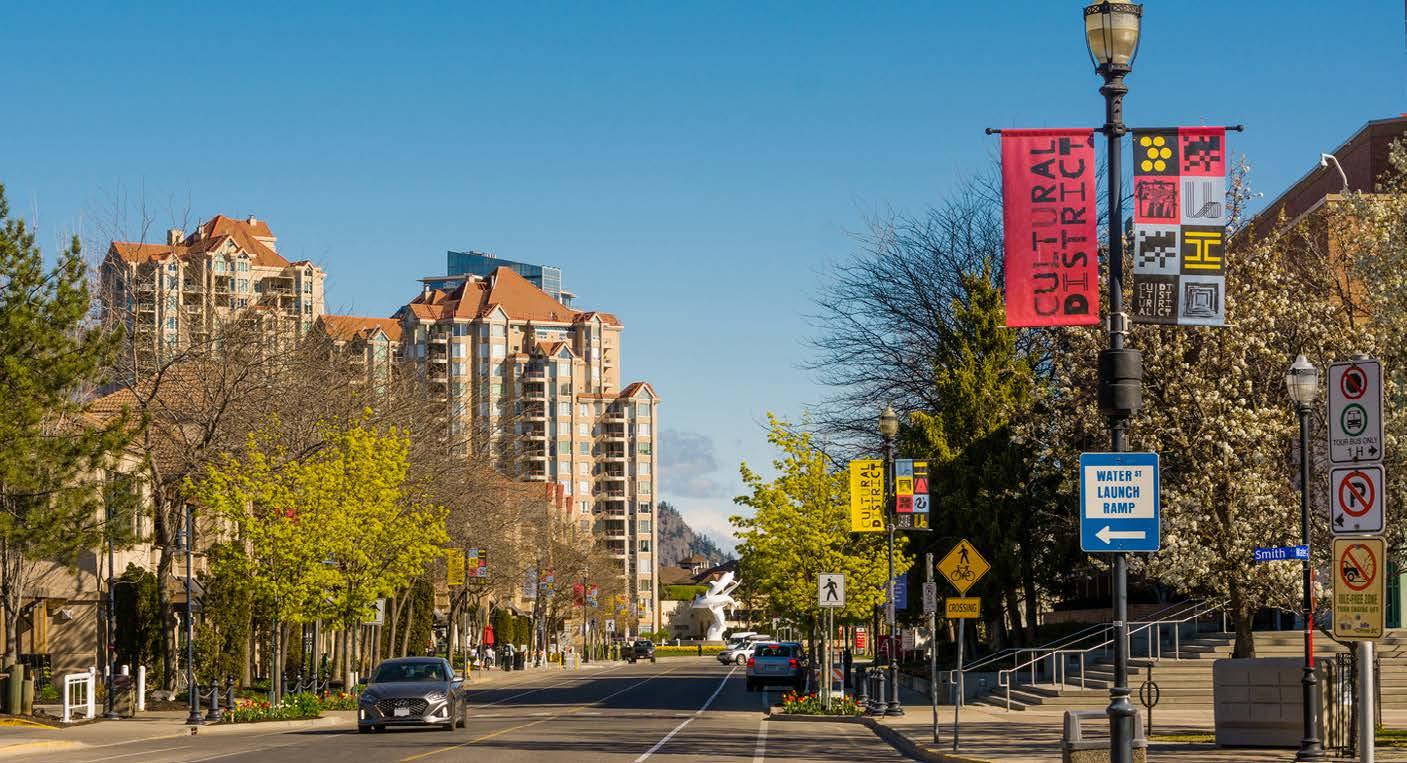
City of Kelowna 2021 Annual Report 50
Budget Actual Actual 2021 2021 2020 Annual Surplus $ 88,572 $ 68,496 $ 62,755 Amortization of tangible capital assets – 68,824 68,155 Proceeds from disposal of tangible capital assets – 2,098 5,191 Gain on disposal of tangible capital assets – (1,832) (2,067) Write down of tangible capital assets – 540 82 Acquisition of tangible capital assets (235,156) (69,219) (88,013) Contributions of tangible capital assets – (1,854) (2,263) Change in inventory and prepaid expenses – 1,757 (1,409) Increase (decrease) in Net Financial Assets (146,584) 68,810 42,431 Net Financial Assets, beginning of year 342,653 342,653 300,222 Net Financial Assets, end of year $ 196,069 $ 411,463 $ 342,653
consolidated statement of cash flows
For the Year Ended December 31, 2021 (in thousands of dollars)
Net inflow (outflow) of cash and cash equivalents related to the following activities
See accompanying notes to the consolidated financial statements.
51 Financial Information | Consolidated Financial Statements
Actual Actual 2021 2020
Operating Annual surplus $ 68,496 $ 62,755 Adjustment for
items Amortization of tangible capital assets 68,824 68,155 Gain on disposal of tangible capital assets (1,832) (2,067) Write down of tangible capital assets 540 82 Actuarial adjustment on long term debt (2,072) (2,159) Contributions of tangible capital assets (1,854) (2,263) Decrease (increase) in Accounts receivable (17,667) 10,355 Inventory and prepaid expenses 1,757 (1,409) Other assets (3,390) (4,789) Increase (decrease) in Accounts payable (29,690) 17,168 Deferred development cost charges 40,831 4,654 Other liabilities 12,384 (658) 136,327 149,824 Capital Acquisition of tangible capital assets (69,219) (88,013) Proceeds from disposal of tangible capital assets 2,098 5,191 (67,121) (82,8223) Investing Change in investments (32,911) 1,393 Financing Proceeds from issuance of long term debt – 73 Repayment of long term debt (8,964) (10,876) (8,964) (10,803) Net increase (decrease) in cash and cash equivalents 27,331 57,592 Cash and cash equivalents, beginning of year 76,434 18,842 Cash and cash equivalents, end of year $ 103,765 $ 76,434 Non-cash capital activities Acquisition of tangible capital assets through contributions
4) $ 1,854 $ 2,263
non-cash
(Note
notes to the consolidated financial statements
December 31, 2021
(in thousands of dollars)
The notes to the consolidated financial statements are an integral part of the statements. They explain the significant accounting and reporting policies and principles underlying these statements. They also provide relevant supplementary information and explanations which cannot be conveniently expressed in the consolidated financial statements.
The consolidated financial statements are the responsibility of and prepared by management in accordance with Canadian Public Sector Accounting Standards (PSAS). The preparation of these consolidated financial statements necessarily involves the use of estimates based on management’s judgment, particularly when transactions affecting the current accounting period cannot be finalized with certainty until future periods.
1. significant accounting policies
Basis of presentation
The City of Kelowna’s resources and operations are segregated into General, Airport, Wastewater Utility, Water Utility, Development Cost Charges and Statutory Reserve Funds for accounting and financial reporting purposes. The consolidated financial statements include all the accounts of these funds. All material interfund transactions and balances have been eliminated within the consolidated financial statements.
On March 11, 2020 the World Health Organization officially declared the COVID19 outbreak a pandemic. The pandemic has forced governments to implement extraordinary measures to slow the progress of infections and to stabilize disrupted economies and financial markets. The City has deployed initiatives in order to protect the health and safety of its employees, to support its customers, and mitigate the impact of the crisis while ensuring continuity of its activities. Although decreased flights and passenger volumes have significantly impacted the Airport, the impact to the rest of the City’s operations has not been as significant. As of this time, it is difficult to assess the impact of the City’s future results as it is dependent on the length and severity of the pandemic. Management will continue to monitor and assess the situation and respond accordingly.
Accrual accounting
The accrual method for reporting revenues and expenses has been used. Revenues are recognized in the period in which the transactions or events occur that give rise to the revenues. Expenses are recognized in the period in which the goods or services are acquired and a liability is incurred.
Assets held for resale
Assets held for sale are those expected to be sold within one year. Assets are valued at the lower of cost or expected net realizable value. Cost includes amounts for improvements required to prepare the asset for sale.
Inventory
Inventory is valued at the lower of cost, determined principally on a weighted average and specific item basis, or replacement cost.
Municipal Finance Authority cash deposits and demand notes
The City issues the majority of its debt instruments through the Municipal Finance Authority. As a condition of these borrowings, a portion of the debenture proceeds is withheld by the Municipal Finance Authority as a debt reserve fund. The City also executes demand notes in connection with each debenture whereby the City may be required to loan certain amounts to the Municipal Finance Authority. These demand notes are contingent in nature. The Debt Reserve and Demand Note balances are as follows:
City of Kelowna 2021 Annual Report 52
2021 2020 Cash deposits held by MFA $ 1,833 $ 1,812 Demand notes held by MFA 4,135 4,152 $ 5,968 $ 5,964
Municipal pension plan
The City of Kelowna’s pension plan follows the guidelines of the Municipal Pension Plan which is administered by the Province of British Columbia for all British Columbia municipalities. The City and its employees contribute to the Municipal Pension Plan (a jointly trusteed pension plan). The board of trustees, representing plan members and employers, is responsible for administering the plan, including investment of assets and administration of benefits. The plan is a multi-employer defined benefit pension plan.
Reserves for future expenditures
Reserves for future expenditures are non-statutory reserves which represent an appropriation of surplus for specific purposes. Transfers to reserves for future expenditures include funds to finance incomplete projects and accumulations for specific purposes.
Statutory reserve funds
The use of these funds is restricted by the Community Charter and associated Municipal Bylaws. Statutory reserve funds are funded 100% by cash and portfolio investments.
Intangible assets
Intangible assets are not reflected in these consolidated financial statements. They include works of art and historic assets located throughout the City.
Interest capitalization
The City of Kelowna only capitalizes interest on projects being financed internally which will require debenture borrowing upon completion. Interest is calculated on monthly expenditures at the bank prime rate less 2%.

Work in progress
Work in
progress represents capital projects under construction but not yet completed and are valued at cost.
Tangible capital assets
The City records tangible capital assets, including assets held as work in progress or capital lease, at cost in the period they were acquired or when the asset is put into use.
All tangible capital assets are valued at cost which includes all costs directly attributable to acquisition, construction, development or betterment of the tangible capital asset.
Assets owned by the City but not paid for by the City including contributions, dedications, gifts and donations, are valued at fair value at the date of contribution, dedication, gift or donation, where fair value is reasonably determinable.
Contributions of tangible capital assets
Tangible capital assets received as contributions are recorded at their fair market value.
53 Financial Information | Consolidated Financial Statements
Amortization
The cost less residual value of the tangible capital assets is amortized on a straight-line basis over the useful lives of the asset as follows:
Land and Work in Progress are not amortized.

City of Kelowna 2021 Annual Report 54
Asset Type Useful Life (years) Asset Type Useful Life (years) Parks infrastructure Vehicles Playground equipment 15 – 20 Cars and light trucks 5 – 10 Artificial turf field 10 – 12 Fire trucks 15 – 20 Washrooms, concessions, picnic shelters 40 – 50 IT infrastructure Outdoor pools, spray pools 50 – 60 Hardware 4 – 5 Building structure 40 – 75 Software 5 – 10 Building improvements Telephone system 7 – 10 Exterior envelope 30 – 40 Infrastructure HVAC systems 10 – 12 (dependent upon component and material) Roof 15 – 20 Electrical 20 – 25 Electrical, plumbing and fire 15 – 20 Water 10 – 100 Site works - asphalt, water and sewer lines, etc 10 – 100 Wastewater 10 – 100 Machinery & equipment Drainage 10 – 100 General equipment 7 – 10 Transportation 10 – 100 Grounds equipment and machinery 10 – 15 Heavy construction equipment 5 – 10
Revenue recognition
Taxation revenue
Annual levies for non-optional municipal services and general administrative services are recorded as taxes for municipal purposes. Levies imposed by other taxing authorities are not included as taxes for municipal purposes. Taxes are recognized as revenue in the year they are levied.
Through the BC Assessment appeal process taxes may be adjusted by way of supplementary roll adjustments. The effect of these adjustments on taxes are recognized at the time they are awarded.
Fees and charges revenue
Charges for transportation, environmental health, building permits, water, wastewater, and airport are included in this category. These revenues are recorded on the accrual basis and recognized as earned which is usually when services are provided or facilities are utilized.
Development Cost Charges (DCC) contributions
Development Cost Charges (DCC) contributions are recognized as revenue during the period in which the related costs are incurred.
Government transfers
Government transfers are recognized as revenue in the period that the transfer is authorized, eligibility criteria, if any, has been met by the City, and a reasonable estimate of the amount to be received can be made.
Investment income
The City’s investments are disclosed in Note 3.
Investment income is recorded on the accrual basis and recognized when earned.
A portion of the City’s investments are invested in pooled funds of the Municipal Finance Authority of British Columbia. Earnings on these funds are allocated to the members from time to time based on the market value of the pool. The City recognizes only its share of the realized earnings of the pool. This revenue is recorded as investment income and the amount is added to the cost base of the investment.
To the extent that investments have no stated rate of return, investment income is recognized as it is received.
Expenses
Expenses are recorded in the period in which the goods or services are acquired and a liability is incurred.
Liability for contaminated sites
Contaminated sites are a result of contamination being introduced into air, soil, water or sediment of a chemical, organic or radioactive material or live organism that exceeds an environmental standard. The liability is recorded net of any expected recoveries. A liability for remediation of contaminated sites is recognized when a site is not in productive use and all of the following criteria are met:
• an environmental standard exists;
• contamination exceeds the environmental standard;
• the City is directly responsible; or accepts responsibility;
• it is expected that future economic benefits will be given up; and
• a reasonable estimate of the amount can be made.
The liability is recognized as management’s estimate of the cost of post-remediation including operation, maintenance and monitoring that are an integral part of the remediation strategy for a contaminated site.
In late 2019, the City acquired and accepted responsibility to remediate a site located on 380 Harvey Avenue. Clean up activities took place in 2020/21,primarily consisting of soil delineation and groundwater monitoring and work will continue in 2022. A liability in the amount of $30 (2020 – $47) is based on contractor estimates of the remaining work to be undertaken.
In early 2020 the City acquired and accepted responsibility to clean up contamination found at the site located at 1746 Water Street. Clean up activities took place in 2020/21 and further work will be undertaken in 2022 to remediate the site. This will consist of groundwater and vapour monitoring and sampling, drilling investigation and monitoring to assess plume stability and seasonality. A liability in the amount of $300 (2020 – $170) is based on contractor estimates of the remaining work required to be undertaken. The City’s liability of $330 (2020 – $217) for contaminated sites is included in Accounts payable.
55 Financial Information | Consolidated Financial Statements
Use of estimates
Management has made estimates and assumptions that affect the amounts reported in preparing these financial statements. Actual results could differ from the estimates. Significant areas requiring the use of management estimates relate to the determination of tangible capital assets estimated useful life and related amortization, allowance for doubtful accounts, contaminated site liabilities, landfill post closure costs and settlement costs associated with outstanding legal actions.
2. future accounting changes
PS 3280 Asset retirement obligations
This section revises and replaces the existing Section PS 3270 Solid Waste Landfill Closure and Post-Closure Liability. This section applies to fiscal years beginning on or after April 1, 2022, with early adoption permitted.
PS 3160 Public private partnerships
This section establishes standards on how to account for and report public private partnerships. This section applies to fiscal years beginning on or after April 1, 2023, with early adoption permitted.
PS 3400 Revenues
This section establishes standards on how to account for and report on revenue. This section applies to fiscal years beginning on or after April 1, 2023, with early adoption permitted.
PS 3450 Financial instruments
This section establishes standards for recognizing and measuring financial assets, financial liabilities and non-financial derivatives. This section applies to fiscal years beginning on or after April 1, 2022, with early adoption permitted. Adoption of this standard requires corresponding adoption of PS 1201 Financial Statement Presentation, PS 2601 Foreign Currency Translation and PS 3041 Portfolio Investments in the same fiscal period.
• PS 1201 Financial Statement Presentation
This section revises the general reporting principles and standards for the disclosure of information in the financial statements. This section applies to fiscal years beginning on or after April 1, 2022, with early adoption permitted.
• PS 2601 Foreign Currency Translation
This section revises and replaces the existing Section PS 2600 Foreign Currency Translation. This section applies to fiscal years beginning on or after April 1, 2022, with early adoption permitted.
• PS 3041 Portfolio investments
This section revises and replaces the existing Section PS 3040 Portfolio investments. This section applies to fiscal years beginning on or after April 1, 2022, with early adoption permitted.
Purchased Intangibles, PSG-8
This public sector guideline establishes standards on how to account for and report on purchased intangibles. This public sector guideline applies to fiscal years beginning on or after April 1, 2023, with early adoption permitted.
City of Kelowna 2021 Annual Report 56
3. financial assets and liabilities
Cash and cash equivalents
Cash and cash equivalents consist of cash and short-term investments with maturities of 90 days or less from the date of acquisition.
Accounts receivable
Accounts receivable are recorded net of allowance and are comprised of the following:
Portfolio investments

Portfolio investments are recorded at cost and are comprised of the following:
The quoted market value of the publicly traded shares at December 31, 2021 was $125,060 (2020 – $103,922).
Operating line of credit
The City has an operating line of credit with the Royal Bank of Canada for an authorized amount of $5,000 bearing interest at bank prime rate less 0.50%. At December 31, 2021 the balance outstanding was $nil (2020 – $nil).
57 Financial Information | Consolidated Financial Statements
Type of receivable 2021 2020 Property tax $ 6,736 $ 5,718 Trade receivables 14,295 11,559 Due from government 741 1,058 Due from provincial government 2,827 1,285 Due from regional government 80 41 Utilities 6,565 5,344 Deferred development cost charges 16,206 4,778 $ 47,450 $ 29,783
Type of investment 2021 2020 Municipal Finance Authority investment funds $ 139,658 $ 130,507 Provincial and bank issued bonds 98,401 94,713 Publicly traded shares 72,209 69,016 Guaranteed Investment Certificates and deposit notes 270,442 253,563 Total Portfolio investments $ 580,710 $ 547,799
Deferred revenue
The City records deferred revenue for funds received in advance of services not yet rendered and is recognized into revenue during the period in which the service is provided. The City also records deferred revenue when a contract specifies how the resources are to be used and therefore funds received in advance are deferred until the period in which the requirements are met. Because these funds are restricted in nature they are shown as a liability.
Deferred development cost charges (DCC)
The City collects development cost charges to pay for a proportionate share of infrastructure related to new growth. In accordance with the Local Government Act, these funds must be deposited into a separate reserve fund. Because these funds are externally restricted in nature they are shown as a liability.
Long term debt
Sinking fund installments and mortgage payments on net outstanding debt and loans payable over the next five years and thereafter are as follows:
Total outstanding debt issued was $155,530 and total debt payable at December 31, 2021 was $81,617 (2020 – $92,653).
Total interest paid in 2021 was $3,667 (2020 – $4,052).
Schedule 3 provides a breakdown of long term debt.
City of Kelowna 2021 Annual Report 58
Deferred Revenue by Type 2020 Receipts Interest Transfers Out 2021 Tax prepayments $ 18,666 $ 36,387 $ – $ 34,774 $ 20,279 Construction 15,671 3,052 27 1,033 17,717 Grants 619 783 – 526 876 Other 6,285 14,547 – 10,247 10,585 Local Area Service 4,269 111 – 92 4,288 Total $ 45,510 $ 54,880 $ 27 $ 46,672 $ 53,745
2020 Receipts Interest Transfers Out 2021 Park Land/Development $ 21,344 $ 22,176 $ 473 $ 7,528 $ 36,465 Roads 57,647 18,604 1,083 3,143 74,191 Water 14,842 1,289 256 263 16,124 Wastewater (10,079) 8,771 (115) 772 (2,195) Total Deferred DCC $ 83,754 $ 50,840 $ 1,697 $ 11,706 $ 124,585
Total 2022 $ 10,400 2023 9,152 2024 8,712 2025 8,740 2026 7,620 2027 and thereafter 36,993 Total $ 81,617
4. tangible capital assets (TCA) and work in progress
received in 2021 include:
Schedule 1 provides a break down of tangible capital assets and work in progress.
During the year, tangible capital assets with a cost of $540 (2020 – $82) were written off due to impairment. During the year, no interest was capitalized $nil (2020 – $nil).

59 Financial Information | Consolidated Financial Statements
2021 2020 2021 Tangible 2020 Tangible Work in capital Work in capital progress assets (NBV) progress assets (NBV) Land $ – $ 348,576 $ – $ 339,192 Land improvements 336 33,079 86 35,243 Buildings 9,323 187,870 9,015 188,373 Infrastructure 15,323 1,170,786 13,420 1,180,216 Machinery and equipment 1,886 81,857 1,571 80,477 $ 26,868 $ 1,822,168 $ 24,092 $ 1,823,501 Contributions
Type of contribution 2021 2020 Land $ 1,838 $ 2,263 Infrastructure 16 –Total Contributed tangible capital assets $ 1,854 $ 2,263
5. accumulated surplus

City of Kelowna 2021 Annual Report 60
Investment Reserves for in Tangible Future Statutory Fund Capital Total Total Expenditures Reserves Surpluses Assets 2021 2020 Accumulated surplus, beginning of year $ 280,128 $ 97,128 $ 64,545 $ 1,761,366 $ 2,203,167 $ 2,140,412 Annual surplus (deficit) 4,873 1,761 109,938 (48,076) 68,496 62,755 Transfers 32,918 17,133 (50,051) – – –Acquisition of tangible capital assets, net (7,946) – (46,744) 54,690 – –Repayment of long term debt – – (8,964) 8,964 – –Accumulated surplus, end of year $ 309,973 $ 116,022 $ 68,724 $ 1,776,944 $ 2,271,663 $ 2,203,167
Accumulated Surplus detail as follows:

61 Financial Information | Consolidated Financial Statements
Balances, Beginning of Transfer Transfer Annual Balances, Description Year From To Surplus End of Year Non-Statutory Reserves General Fund reserve $ 220,016 $ 19,989 $ 31,458 $ 4,667 $ 236,152 Airport Fund reserve 28,368 9,385 15,297 124 34,404 Waste Water Fund reserve 10,947 593 6,176 15 16,545 Water Fund reserve 20,797 3,705 5,713 67 22,872 280,128 33,672 58,644 4,873 309,973 Statutory Reserves Parking reserve 7,473 3,309 4,435 118 8,717 Land reserve 9,296 5,681 3,140 192 6,947 Capital works, machinery and equipment reserve 80,359 16,678 35,226 1,451 100,358 97,128 25,668 42,801 1,761 116,022 Surplus by Fund General Fund surplus 4,763 104,058 30,869 73,278 4,852 Airport Fund surplus 2,407 17,448 2,805 14,643 2,407 Waste Water Fund surplus 48,036 11,469 4,159 10,776 51,502 Water Fund surplus 9,339 11,594 977 11,241 9,963 Accumulated Surplus 64,545 144,569 38,810 109,938 68,724 Investment in Non Financial Assets Investment in tangible capital assets 1,761,366 8,964 72,618 (48,076) 1,776,944 Accumulated Surplus $ 2,203,167 $ 212,873 $ 212,873 $ 68,496 $ 2,271,663
6. taxation
Taxation revenue comprises the following amounts raised less transfers to other governments:

City of Kelowna 2021 Annual Report 62
2021 2020 Taxes collected Property taxes $ 268,596 $ 239,997 Local improvement levies 146 146 Frontage tax – water 1,668 1,548 Specified sewer area recoveries 1,293 1,292 Grants in lieu of taxes 472 655 Levies – library 6,916 6,797 Levies –other 1,341 1,282 280,432 251,717 Less transfers to other governments Province of BC (school taxes) 79,658 60,941 BC Assessment Authority 2,272 2,262 Regional Hospital District 13,630 13,105 Regional District of Central Okanagan 13,506 13,004 109,066 89,312 Net taxes available for municipal purposes $ 171,366 $ 162,405
7. government transfers
Government transfers are the major source of transfers to the City. Government transfers received are for completed projects that meet the required criteria as set out by the Government body providing the funding. Government transfers do not include grants in lieu of taxes received from the Federal and Provincial governments. During the year $203 (2020 – $nil) remained as deferred revenue for future expenditures. In 2021 the City received and recorded as revenue the following transfers:

63 Financial Information | Consolidated Financial Statements
2021 2020 Operating transfers Federal $ 3,699 $ 176 Provincial 27,403 27,078 Other governments 175 224 31,277 27,478 Capital transfers Federal 760 357 Provincial 3,772 6,720 Other governments 20 24 4,552 7,101 Total Government transfers $ 35,829 $ 34,579
8. contingent liabilities
Regional District of Central Okanagan
Regional District debt is, under the provisions of the Local Government Act, a direct, joint and several liability of the District and each member municipality within the District including the City of Kelowna.
The loan agreements with the Regional District of Central Okanagan and the Municipal Finance Authority provide that if at any time the scheduled payments provided for in the agreements are not sufficient to meet the Authority’s obligation with respect to such borrowing, the resulting deficiency becomes a liability of the member municipalities.
Pension liability
The employer and its employees contribute to the Municipal Pension Plan (a jointly trusteed pension plan). The board of trustees, representing plan members and employers, is responsible for administering the plan, including investment of assets and administration of benefits. The plan is a multi-employer defined benefit pension plan. Basic pension benefits are based on a formula. As at December 31, 2020, the plan has about 220,000 active members and approximately 112,000 retired members. Active members include approximately 42,000 contributors from local governments.
Every three years, an actuarial valuation is performed to assess the financial position of the plan and adequacy of plan funding. The actuary determines an appropriate combined employer and member contribution rate to fund the plan. The actuary’s calculated contribution rate is based on the entry-age normal cost method, which produces the long-term rate of member and employer contributions sufficient to provide benefits for average future entrants to the plan. This rate may be adjusted for the amortization of any actuarial funding surplus and will be adjusted for the amortization of any unfunded actuarial liability.
The most recent valuation for the Municipal Pension Plan as at December 31, 2018, indicated a $2.9 billion funding surplus for basic pension benefits on a going concern basis.
The City of Kelowna paid $8,209 (2020 – $7,840) for employer contributions while employees contributed $6,834 (2020 – $6,548) to the plan in fiscal 2021.
The next valuation will be as at December 31, 2021, with results available in 2022.
Employers participating in the plan record their pension expense as the amount of employer contributions made during the fiscal year (defined contribution pension plan accounting). This is because the plan records accrued liabilities and accrued assets for the plan in aggregate, resulting in no consistent and reliable basis for allocating the obligation, assets and cost to individual employers participating in the plan.
Post employment benefits and compensated absences
The City of Kelowna does not accrue expenses for post-employment benefits and compensated absences. Post-employment benefits are benefits expected to be provided after employment but before retirement to employees and their beneficiaries. Compensated absences are benefits for employee absences for which employees will be paid (i.e. sick leave). City employees retiring do not receive any post-employment related benefits that either vests or accrues over the period of employment. Compensated absences: such as sick leave benefits do not accrue and are not vested. The City recognizes the expense for compensated absences when the event obligates the City to pay.
Legal actions
The City of Kelowna is currently engaged in certain legal actions, the outcome of which is not determinable at this time. Accordingly, no provision has been made in the accounts for these actions.
The amount of loss, if any, arising from these contingent liabilities will be recorded in the accounts in the period in which the loss is realized. The City of Kelowna has insurance policies and financial reserves to offset associated risks.
City of Kelowna 2021 Annual Report 64
9. commitments Agreements, contracts and purchase orders
The City has entered into various agreements and contracts for services and construction with periods ranging from one to five years. The City has purchase orders open as at December 31, 2021 which have not been recorded in the accounts. The balance of these open purchase orders is not determinable at this time. The funding for the majority of these obligations has been set aside in reserves for future expenditures. These amounts will be recorded in the accounts in the period the goods and services, to which they relate, are received.
Landfill closure and post closure costs
As required by PSAS and regulated by the Ministry of Environment & Climate Change Strategy, the City has agreed to obligations regarding the operation of the landfill site. These obligations include recognition of closure and post-closure liability. As currently engineered, and based on current waste disposal patterns, the landfill has a remaining life expectancy of 87 years. The estimated length of time needed for post-closure is 80 years.
The present value of future cash flows for the expected landfill closure and post-closure care costs is estimated to be $30,660 based on a Design, Operations and Closure Plan (DOCP) completed in 2018.
The City’s liability for these landfill closure and post-closure care cost expenditures is recognized as the landfill site’s capacity is used. The reported liability of $4,429 (2020 – $4,278) represents the portion of the estimated total expenditure recognized as at December 31, 2021. The remaining capacity of the landfill site is estimated at 26.8 million tonnes which is 90% of the site’s total capacity. The liability and annual expenditure is calculated based on the ratio of current usage to the total capacity of the site and the discounted estimated future cash flows associated with closure and post-closure activities using an inflation rate of 0.96% and discount rate of 2.25%.
The reported liability is based on estimates and assumptions with respect to events extending over the remaining life of the landfill. Future events may result in significant changes to the estimated remaining useful life, estimated total costs, total or used capacity and the estimated liability. These would be recognized prospectively as a change in estimate when applicable.
YMCA of Okanagan Association loan guarantee agreement
The City has, under the terms of the partnering agreement between the City of Kelowna and YMCA of Okanagan Association, guaranteed repayment in the event that the YMCA of Okanagan Association defaults on a $1,800 20-year loan issued in 2001. Under the agreement the City shall resume operation of the facility and assume responsibility for the repayment of the debt incurred by the YMCA of Okanagan Association. During 2010 an amendment was made to the agreement for additional financing of $700 for a 20-year term. Both loans have an interest rate of lender’s prime less 0.5%. As at December 31, 2021, the outstanding loan balance was $537 (2020 – $613). The City does not expect to make any payments on the guarantee and no amounts have been accrued in the financial statements.
Multi-Purpose Facility Public/Private Partnership
The City of Kelowna, subject to the terms and conditions of the Tripartite Agreement between the City of Kelowna, Royal Bank of Canada and RG Arenas (Kelowna) Ltd., RG Properties Ltd., Prospero Canadian Land Investment Fund Ltd. group of companies, committed to the annual purchase of community use time at the Multi-Purpose Facility with the option to make a lump sum payment before the 15th day of one of year 6, 11, 16, 21 or 26, commencing with the year of substantial completion (November 10, 1999).
The City chose to exercise its option to make a lump sum payment of $6,727 in 2019 (Year 21) as prepayment for community use time with no further amounts payable under the Tripartite Agreement until November 9, 2029.
The balance of $5,382 (2020 – $6,055) in prepaid community use time is included in Prepaid expenses.
Royal Canadian Mounted Police Services
The Province of British Columbia and the Federal Government have an agreement with the Royal Canadian Mounted Police to provide police services for various municipalities in the Province, including the City of Kelowna. This agreement has a 20 year term expiring on March 31, 2032.
65 Financial Information | Consolidated Financial Statements
10. long term investments
Kelowna Developments Ltd.
The investment in Kelowna Developments Ltd., a wholly owned subsidiary, is carried at its cost of $2.00. The company is inactive with no assets or liabilities and is being retained for potential future use.
RG Arenas (Kelowna) Ltd.
The investment in preferred shares in RG Arenas (Kelowna) Ltd. is carried at its cost of $6,000. The shares were purchased under the terms of the Preferred Share Agreement between the City of Kelowna, RG Arenas (Kelowna) Ltd., RG Properties Ltd., and Prospero Canadian Land Investment Fund Ltd. and represents the City’s investment in the Multi-Purpose facility. The City has the option to purchase the Facility for the sum of $1.00 and the surrender of the preferred shares within the 10 year period beginning 30 years and one week from the date of Substantial Completion of the Facility, that being November 19, 2029. If exercised, the Facility will be conveyed to the City free and clear of all liens, charges and encumbrances.
11. letters of credit
In addition to the performance deposits reflected in cash balances, the City is holding irrevocable Letters of Credit in the amount of $68,816 (2020 – $49,957) which were received from depositors to ensure their performance of works to be undertaken within the City. These amounts are not reflected in the financial statements but are available to satisfy any liabilities arising from non-performance by the depositors. Included in the $68,816, the City is holding irrevocable Letters of Credit in the amount of $18,155 (2020 – $6,180) which are received from developers to ensure payment of development cost charges in future years.
12. trust funds
In accordance with PSAS, trust funds are not included in the City’s consolidated financial statements. The City administers a Cemetery Maintenance Fund for the perpetual care and maintenance of the City owned and operated cemetery. As at December 31, 2021 the Trust Fund balance is $3,348 (2020 – $3,178).
13. segmented information
The City of Kelowna is connecting communities and providing a multitude of services to the citizens of Kelowna. The City’s operations and activities are organized and reported by funds and departments. The General Fund reports on operations, funded primarily by property taxes, which include services provided by the City such as general government, protective services, transportation services, recreation and cultural services, as well as public health, and environmental and development services. The City also operates Kelowna International Airport (the Airport) and City utilities comprised of the wastewater and water systems that are self-sustaining operations. Operating results reported by the following segments are included in Schedule 2.
General government
General Government operations are primarily funded by property taxation and business tax revenues. The general revenue reported under this segment includes revenues associated with taxation, business tax revenues and senior government payments in lieu of taxes. These revenues have not been apportioned to other departments supported by the General Fund. The expenses within this segment are for executive and legislative costs, general administration, and other general government areas such as community service grants and rental property operating costs within the municipality.
Protective services
Protective services are comprised of fire protection services, building inspection services, bylaw enforcement and police services provided by the Royal Canadian Mounted Police.
The fire department is responsible for effective fire protection and public safety services to the City. This includes fire suppression and rescue, prevention and investigation, specialty rescue/first medical responses and fire safety inspections.
City of Kelowna 2021 Annual Report 66
Police services, provided by the Royal Canadian Mounted Police, include administration, crime investigation and prevention, traffic, prisoner custody and court liaison expenses.
Transportation services
Transportation services are responsible for the delivery of municipal public works services related to the planning, development and maintenance of streets and roads; bridges; drainage systems; street lights; traffic lights and signals; parking lots and on-street parking; and public transit as well as maintenance of workshops, yards and other buildings. The mandate is to provide a safe, efficient, environmentally-sensitive and cost-effective transportation network.
Recreation and cultural services
Recreation and cultural services are comprised of services related to recreation, leisure and culture including administration and program costs as well as grounds and building maintenance. Facilities managed within this segment include parks and playgrounds, arenas, swimming pools, beaches, boat launches, stadiums as well as community and multi-age activity centers. Some of the larger facilities that the City owns and/or operates include the H2O Adventure & Fitness Centre, Parkinson Recreation Centre, Kelowna Community Theatre, Kelowna Museum, Kelowna Library, Kelowna Art Gallery, Capital News Center and the Rotary Centre for the Arts.
Other services (Public Health/Environmental/Development services)
Public health services are comprised of cemetery operations and maintenance, environmental and development services including community planning and zoning as well as landfill operations.
Airport services
The Airport, owned and operated by the City of Kelowna, provides quality services in a safe and cost effective manner in compliance with Federal regulations. The Airport is self-funded, provides a payment in lieu of property taxes to the City of Kelowna, and is accounted for in its own fund.
Wastewater services
Kelowna’s wastewater system collects, conveys, treats and disposes of domestic wastewater (derived from the home) and industrial wastewater (resulting from business use, manufacturing and processing). The system currently services approximately 75% of Kelowna’s population and expansion to unserviced areas continues. Kelowna’s wastewater system has a treatment capacity of 70 million litres per day. Wastewater Utility is accounted for in its own fund.
Water services
The Water Utility is responsible for planning, expansion, operation and maintenance of the City’s Water Supply System and is one of four water suppliers operating within Kelowna’s boundaries. The Water Utility is accounted for in its own fund.

Statutory reserves
Statutory Reserves include funds for parking, land and capital works, machinery and equipment.
67 Financial Information | Consolidated Financial Statements
14. expenses by object
Total consolidated expenses by object are itemized in Schedule 2 – Segmented information.
15. budget data
The budget figures are from the Annual Five-Year Financial Plan Bylaw adopted before May 15th of each year. Subsequent amendments have been made by Council to reflect changes in the budget as required by law. Amortization of tangible capital assets was not included in the budget. The table below shows the reconciliation between the approved budget and the budget presented in these consolidated financial statements.
16. contractual rights
The City of Kelowna contractual rights arise from rights to receive payments from lease agreements. During 2020, the City of Kelowna entered into a long term lease agreement with Rise Commercial Developments Inc to lease 350 Doyle Avenue commencing in 2021. The long term lease is for $7,000 to be received over 80 years with an option to renew for an additional 19 years.
As of December 31, 2021, the City of Kelowna received a $2,700 prepayment with the remaining balance of $4,300 in the form of non-cash consideration, estimated to be received in 2024.
17. comparative figures
Certain comparative figures have been reclassified to conform to the presentation format adopted in the current year.
City of Kelowna 2021 Annual Report 68
Budget Amount Revenues: Operating budget $ 312,263 Capital budget 37,777 350,040 Expenses: Operating budget 261,468 Capital budget 235,156 496,624 Annual deficit per approved budget (146,584) Add: tangible capital asset purchases 235,156 Annual surplus per statement of operations $ 88,572

schedule 1 – tangible capital assets
For the Year Ended December 31, 2021 (in thousands of dollars)
City of Kelowna 2021 Annual Report 70 Land Machinery Land Improvements Buildings Vehicles & Equipment Cost Balance, beginning of year $ 339,192 $ 79,111 $ 357,148 $ 36,152 $ 108,235 Add: additions during the year 12,647 325 2,434 3,425 1,986 Add: transfers to tangible capital assets – 42 5,658 468 3,746 Less: assets held for resale (3,101) – – – –Less: disposals during the year (162) – – (663) (69) Balance, end of year 348,576 79,478 365,240 39,382 113,898 Accumulated Amortization Balance, beginning of year – 43,868 168,775 21,697 51,687 Add: amortization – 2,531 8,595 2,148 5,006 Less: accumulated amortization on disposals – – – (605) (21) Less: amortization on assets held for resale – – – – –Balance, end of year – 46,399 177,370 23,240 56,672 Net Book Value of Tangible Capital Assets $ 348,576 $ 33,079 $ 187,870 $ 16,142 $ 57,226 Roads, Lanes, Bridges, Underground, Plant & Sidewalks & Tunnels & Overhead & Airport Facilities Bike Paths Overpasses Other Networks Infrastructure Cost Balance, beginning of year $ 219,880 $ 578,887 $ 35,152 $ 1,197,431 $ 85,222 Add: additions during the year 552 7,166 134 6,426 3,928 Add: transfers to tangible capital assets 8,449 3,858 1,716 6,335 –Less: assets held for resale – – – – –Less: disposals during the year – (137) – (2) –Balance, end of year 228,881 589,774 37,002 1,210,190 89,450 Accumulated Amortization Balance, beginning of year 96,763 352,301 10,222 441,166 36,204 Add: amortization 7,575 19,087 558 18,052 2,652 Less: accumulated amortization on disposals – (69) – – –Less: amortization on assets held for resale – – – – –Balance, end of year 104,338 371,319 10,780 459,218 38,856 Net Book Value of Tangible Capital Assets $ 124,543 $ 218,455 $ 26,222 $ 750,972 $ 50,594 MACHINERY & EQUIPMENT INFRASTRUCTURE

71 Financial Information | Schedule 1 – Tangible Capital Assets Subtotal Machinery & Computers Equipment $ 22,321 $ 166,708 1,930 7,341 175 4,389 – –(639) (1,371) 23,787 177,067 12,847 86,231 2,620 9,7747 (169) (795) – –15,298 95,210 $ 8,489 $ 81,857 Subtotal Work in Total Total Infrastructure Progress 2021 2020 $ 2,116,872 $ 24,092 $ 3,083,123 $ 2,996,781 18,206 33,223 74,176 95,375 20,358 (30,447) – –– – (3,101) (5,046) (139) – (1,672) (3,987) 2,155,297 26,868 3,152,526 3,083,123 936,656 – 1,235,530 1,168,103 47,924 – 68,824 68,155 (69) – (864) (781) – – – 53 984,511 – 1,303,490 1,235,530 $ 1,170,786 $ 26,868 $ 1,849,036 $ 1,847,593
schedule 2 – segmented information
For the Year Ended December 31, 2021 (in thousands of dollars)
City of Kelowna 2021 Annual Report 72 General Protective Recreation & Other Government Services Transportation Cultural Services Revenue Taxation $ 168,237 $ – $ 146 $ – $ –Fees and charges 19,799 13,179 14,493 3,618 30,942 Interest earned 8,612 – – – –DCC contributions – – 3,143 7,528 –Government transfers 6,489 1,973 15,067 1,651 219 Other capital contributions 3,069 – – 277 –Gain on disposal of tangible capital assets 1,298 – 513 – 58 207,504 15,152 33,362 13,074 31,219 Expenses Salaries and benefits 24,512 34,034 9,717 11,819 9,095 Contract and professional services 7,720 1,584 28,839 7,565 8,692 RCMP Contract – 36,778 – – –Materials and supplies 6,212 1,685 6,270 11,334 1,636 Equipment 671 386 3,361 1,794 2,540 Allocations (7,069) (145) (216) (193) 1,841 Cost recoveries (1,449) (2,690) (9,610) (147) (1,457) Grants and external transfers 2,668 84 5 1,777 390 Utilities 188 309 1,353 2,065 346 Loss on disposal of tangible capital assets – – 37 – –Write down of tangible capital assets 470 – 70 – –Amortization of tangible capital assets 5,543 1,885 26,752 8,087 2,297 Total before Debt 39,466 73,910 66,578 44,101 25,380 Debt interest and fiscal services 2,445 – – – –Total operating expenses 41,911 73,910 66,578 44,101 25,380 Annual Surplus (Deficit) $ 165,593 $ (58,758) $ (33,216) $ (31,027) $ 5,839

73 Financial Information | Schedule 2 – Segmented Information Statutory Airport Wastewater Water Reserves 2021 $ – $ 1,293 $ 1,690 $ – $ 171,366 21,814 19,765 18,506 69 142,185 184 827 225 1,692 11,540 – 772 263 – 11,706 7,269 163 2,998 – 35,829 262 414 533 – 4,555 – – – – 1,869 29,529 23,234 24,215 1,761 379,050 4,304 3,756 4,290 – 101,527 1,366 620 500 – 56,886 – – – – 36,778 6,245 1,625 1,415 – 36,422 10 854 784 – 10,400 1,972 2,894 925 – 9 (609) (240) (636) – (16,838) – – 9 – 4,933 582 1,131 1,395 – 7,369 – – – – 37 – – – – 540 7,544 10,429 6,287 – 68,824 21,414 21,069 14,969 – 306,887 584 350 288 – 3,667 21,998 21,419 15,257 – 310,554 $ 7,531 $ 1,815 $ 8,958 $ 1,761 $ 68,496
schedule 2 – segmented information
For the Year Ended December 31, 2020 (in thousands of dollars)
City of Kelowna 2021 Annual Report 74 General Protective Recreation & Other Government Services Transportation Cultural Services Revenue Taxation $ 159,393 $ – $ 146 $ – $ –Fees and charges 12,399 7,650 12,686 3,169 28,203 Interest earned 9,129 – 151 – –DCC contributions – – 2,869 6,210 –Government transfers 12,282 752 12,698 1,107 141 Other capital contributions 3,309 – – – –Gain on disposal of tangible capital assets 884 – 1,760 243 –197,396 8,402 30,310 10,729 28,344 Expenses Salaries and benefits 21,435 30,722 9,811 10,162 8,490 Contract and professional services 5,085 2,611 25,331 7,701 8,731 RCMP Contract – 29,756 – – –Materials and supplies 6,171 1,630 5,784 11,232 1,495 Equipment 664 405 3,592 1,594 2,237 Allocations (7,390) (29) (109) (188) 1,919 Cost recoveries (1,908) (2,232) (9,537) (177) (1,469) Grants and external transfers 2,211 81 4 1,591 226 Utilities 154 296 1,351 1,821 359 Loss on disposal of tangible capital assets 21 – – – 798 Write down of tangible capital assets – – 82 – –Amortization of tangible capital assets 4,782 1,823 27,555 7,971 2,043 Total before Debt 31,225 65,063 63,864 41,707 24,829 Debt interest and fiscal services 2,484 – – – –Total operating expenses 33,709 65,063 63,864 41,707 24,829 Annual Surplus (Deficit) $ 163,687 $ (56,661) $ (33,554) $ (30,978) $ 3,515

75 Financial Information | Schedule 2 – Segmented Information Statutory Airport Wastewater Water Reserves 2020 $ – $ 1,292 $ 1,574 $ – $ 162,405 18,887 18,754 16,043 355 118,146 301 1,044 408 2,166 13,199 – 5,056 256 – 14,391 1,149 186 6,264 – 34,579 194 850 361 – 4,714 – – – – 2,887 20,531 27,182 24,906 2,521 350,321 4,221 3,675 3,954 – 92,470 1,031 771 637 – 51,898 – – – – 29,756 6,317 1,494 1,518 – 35,641 16 879 749 – 10,136 1,852 3,077 953 – 85 (398) (333) (525) – (16,579) – – 13 – 4,126 537 1,133 1,274 – 6,925 – – – – 819 – – – – 82 7,748 10,531 5,702 – 68,155 21,324 21,227 14,275 – 283,514 584 687 297 – 4,052 21,908 21,914 14,572 – 287,566 $ (1,377) $ 5,268 $ 10,334 $ 2,521 $ 62,755
schedule 3 – long term debt
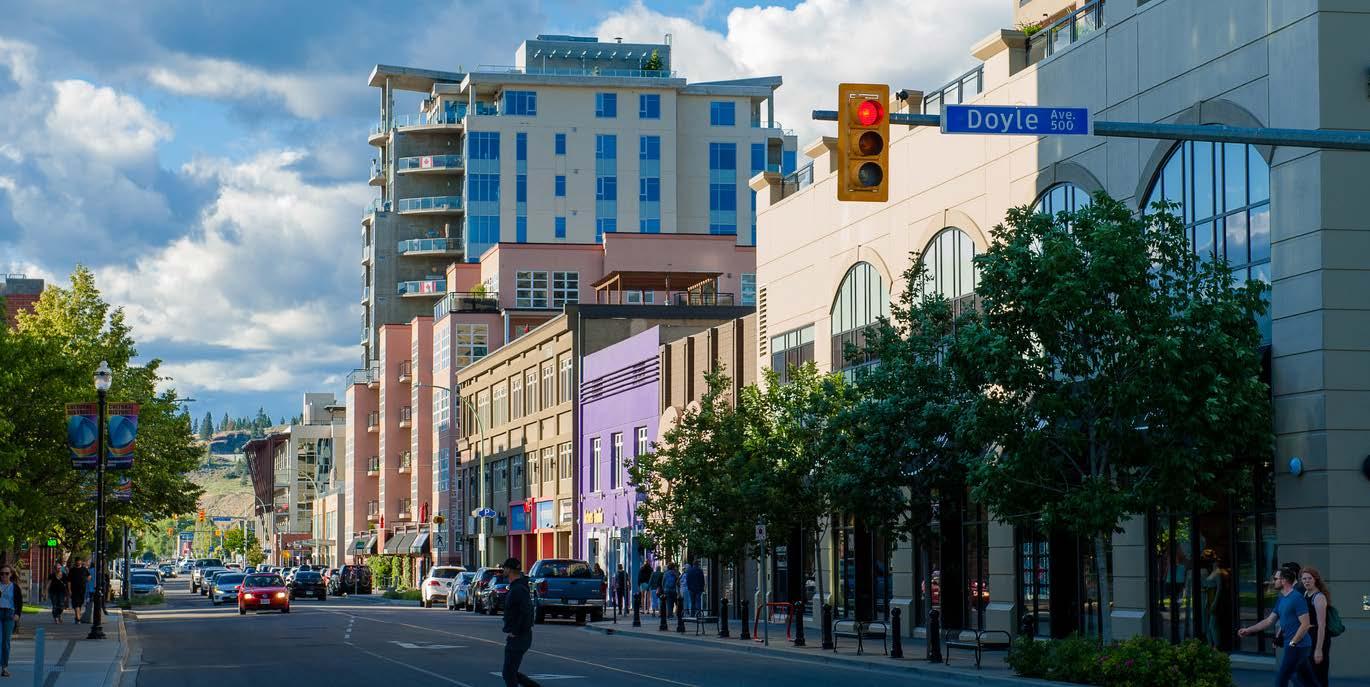
For the Year Ended December 31, 2021 (in thousands of dollars)
Long term debt – General Fund
City of Kelowna 2021 Annual Report 76
Debenture Debt Debt Debt Sinking Fund Current Year of Balance Amount Balance Balance Interest Maturity Purpose Dec. 31/20 of Issue Dec. 31/21 Dec. 31/21 Rate Public Works % 2022 Chapman Parkade $ 607 $ 4,071 $ 311 $ 3,760 2.25 Local Improvements 2035 Lawrence Ave LAS 268 345 253 92 3.00 Recreation and Culture 2021 Kokanee Gym Facility 38 500 – 500 1.75 2027 H2O Centre 12,145 27,500 10,607 16,893 2.25 2027 Kokanee Gymnastic 353 800 309 491 2.25 2028 H2O Centre 991 2,000 883 1,117 2.90 2035 Police Facilities 16,208 20,000 15,368 4,632 2.75 2035 Library Parkade Ext & Memorial Parkade 12,156 15,000 11,526 3,474 2.75 2036 Police Facilities 14,466 17,000 13,776 3,224 2.60 2037 Police Facilities 2,655 3,000 2,533 467 3.15 2038 Police Facilities 1,257 1,360 1,204 156 3.15 Total Debt – General Fund $ 61,144 $ 91,576 $ 56,770 $ 34,806
schedule 3 – long term debt

For the Year Ended December 31, 2021 (in thousands of dollars)
Long term debt – Wastewater Fund Debenture Debt
77 Financial Information | Schedule 3 – Long Term Debt
Debt Debt Sinking Fund Current Year of Balance Amount Balance Balance Interest Maturity Purpose Dec. 31/20 of Issue Dec. 31/21 Dec. 31/21 Rate Specified Area Programs % 2022 Spec. Area 22A – Gerstmar $ 6 $ 40 $ 3 $ 37 0.65 2024 Spec. Area 21A – McKenzie Bench 384 1,350 295 1,055 2.25 2024 Spec. Area 22B – Vista Rd 23 80 17 63 2.25 2024 Spec. Area 22C – Hein Rd 76 266 58 208 2.25 2024 Spec. Area 22D – Elwyn Rd 42 149 32 117 2.25 2024 Spec. Area 22E – Dease Rd 27 96 21 75 2.25 2024 Spec. Area 22F – Mills Rd 97 342 75 267 2.25 2024 Spec. Area 29 – Campion Cambro 248 874 191 683 2.25 2024 Spec. Area 30 – Acland 104 364 80 284 2.25 2025 Spec. Area 20 – North Rutland 2,210 6,822 1,794 5,028 0.91 2025 Spec. Area 28A – Okaview 207 638 168 470 0.91 2028 Spec Area 26 – Fisher Rd 1,001 2,021 893 1,128 2.90 2028 Spec Area 34 – Country Rhodes 216 435 192 243 2.90 2028 Spec Area 36 – Clifton 132 267 118 149 2.90 Sewer Treatment Plant 2031 Brandt’s Creek Tradewaste Treatment 1,792 3,800 1,522 2,278 1.47 Total Debt – Wastewater Fund $ 6,565 $ 17,544 $ 5,459 $ 12,085
schedule 3 – long term debt
For the Year Ended December 31, 2021 (in thousands of dollars)
Long term debt – Water Fund
City of Kelowna 2021 Annual Report 78 Financial Information | Schedule 3 – Long Term Debt
Debenture Debt Debt Debt Sinking Fund Current Year of Balance Amount Balance Balance Interest Maturity Purpose Dec. 31/20 of Issue Dec. 31/21 Dec. 31/21 Rate Specified Area Programs % 2023 Spec Area 16 – Byrns $ 9 $ 39 $ 6 $ 33 2.85 2024 Spec Area 18 – Lakeshore 7 24 5 19 2.25 2028 Spec Area 26 – Fisher Rd 147 297 131 166 2.90 2038 Local Area Service – Aspen Rd 44 48 42 6 3.20 Water Improvement Program 2028 Cedar Creek Pump Station 3,754 7,577 3,346 4,231 2.90 2031 Poplar Point Pump Station Upgrade 1,290 2,000 1,195 805 1.47 Total Debt – Water Fund $ 5,251 $ 9,985 $ 4,725 $ 5,260 Long term debt – Airport Fund Debenture Debt 2025 Airport Expansion $ 4,072 $ 7,500 $ 3,312 $ 4,188 2.75 2026 Airport Expansion 2,242 3,500 1,900 1,600 2.60 2026 Airport Expansion 1,905 3,000 1,611 1,389 2.10 2027 Airport Expansion 5,843 8,000 5,080 2,920 2.80 Total Debt – Airport Fund $ 14,062 $ 22,000 $ 11,903 $ 10,097 Long term debt – Other 2021 Airport – 3770 Bulman road $ 900 $ 4,500 $ - nil 2022 General Land – Diamond Mountain 2,450 6,900 1,225 nil 2023 General Land – Dewdney Park 2,214 2,952 1,476 nil 2029 Airport – Enterprise Rental Car Kiosk 67 73 59 nil Total Debt – Other $ 5,631 $ 14,425 $ 2,760 Total City Long Term Debt $ 92,653 $ 155,530 $ 81,617
schedule 4 – coVid-19 safe restart
grant for local goVernments
For the Year Ended December 31, 2021 (in thousands of dollars)
The COVID-19 Safe Restart Grant was received from the Provincial Government in 2020. The schedule below provides disclosure of funds received, spent and remaining as well as any interest earned on unused funds. A balance at the end of the year represents unused funds received and is included in the General fund reserve.
2021 2020

79 Financial Information | Covid-19 Safe Restart Grant for Local Governments
Balance, beginning of year $ 5,403 $ –COVID-19 Safe Restart Grant received – 7,884 Interest earned 28 –Less funds used to support: Airport revenue losses – (500) Gaming revenue losses (2,436) (1,517) Corporate preparedness planning (536) (464) Community services revenue losses (743) –(3,687) (2,481) Balance, end of year $ 1,716 $ 5,403
statistical review 2017 – 2021

80
statistical review 2017 – 2021
College, CEGEP or other non-university certificate or diploma
education Population 25 – 64 years
High school certificate or equivalent
Business, finance, admin (9,795)
Trades, transport (10,355)
Sales and service occupations (18,165)
Occupation Labour force 15 years and over
University certificate or degree
Apprenticeship or trades certificate or diploma
No certificate, diploma or degree University certificate or diploma below the bachelor level
Management occupations (7,785)
Social science, education, government service and religion (6,815)
Health occupations (5,700)
Natural and applied sciences (3,725)
Art, culture, recreation and sport (2,235) Processing, manufacturing and utilities (1,670)
Natural resources, agriculture and related production (1,420)
Note: Numbers and graphs on this page are updated from Census information available every 5 years. Except for the population graph which has the numbers updated each year from the figures available in kelowna.ca, ”About Kelowna.”
81 Statistical Review
15-19 20-29 30-49 50-64 >65 7,360 20,940 37,225 28,460 31,005 129,500 131,600 133,800 143,148 144,576 2017 2018 2019 2020 2021 population age of population
Source: Statistics Canada, Labour Force Survey as prepared by BC Stats: BC Unemployment Rate by Region.
Note: Full Time Employees (FTE) at the City of Kelowna
Source: City of Kelowna Financial Services Department.
City of Kelowna 2021 Annual Report 82 $186.3 $268.2 $300.2 $342.7 $411.5 2017 2018 2019 2020 2021 net financial assets
millions accumulated surplus billions $1.93 $2.04 $2.14 $2.20 $2.27 2017 2018 2019 2020 2021 acquisition of tangible capital assets millions annual surplus millions unemployment rate for kelowna number of city of kelowna employees 2017 2017 5.4% 937 2017 2017 2018 2018 2018 2018 2019 2019 2019 2020 2021 2019 2020 2020 2020 2021 2021 2021 $88.4 $50.6 4.9% 984 $114.6 $114.3 4.1% 1,006 $129.4 $88.0 $69.2 $98.4 7.2% 1,000 $62.8 $68.5 5.5% 1,019
(liabilities)
83 Statistical Review $272.2 $286.6 $297.6 $287.6 $310.6 $322.7 $400.9 $396.1 $350.3 $379.1 2017 2018 2019 2020 2021 2017 2018 2019 2020 2021 consolidated revenues millions consolidated expenses millions
consolidated expenses by function millions 2017 2018 2019 2020 2021 General government $ 27.20 $ 30.37 $ 31.81 $ 33.69 $ 41.44 Protective services 59.72 60.95 65.55 65.07 73.91 Transportation 63.04 63.74 64.44 63.78 66.47 Recreational & cultural 42.73 44.64 45.46 41.71 44.10 Other services (Incl Natural Gas Legacy) 24.22 26.86 27.71 24.03 25.38 Airport 20.70 23.00 24.50 21.91 22.00 Wastewater 22.89 22.61 22.55 21.91 21.42 Water 11.21 13.46 13.38 14.57 15.26 Loss on disposal of tangible capital assets – 0.46 1.09 0.82 0.04 Write down of tangible capital assets 0.44 0.49 1.16 0.08 0.54 Total 272.15 $ 286.58 $ 297.65 $ 287.57 $ 310.55 consolidated revenues by type millions 2017 2018 2019 2020 2021 Taxation $ 139.40 $ 145.94 $ 155.62 $ 162.40 $ 171.37 Fees and charges 125.62 152.54 150.52 118.15 142.19 Interest earned 10.33 12.82 14.32 13.20 11.54 DCC contributions 9.53 12.93 16.84 14.39 11.71 Government transfers 21.56 49.02 53.02 34.58 35.83 Other capital contributions 10.69 23.03 4.52 4.71 4.56 Gain on disposal of tangible capital assets 5.59 4.60 1.24 2.89 1.87 Total $322.72 $ 400.88 $ 396.08 $ 350.32 $ 379.05
Source: City of Kelowna Financial Services Department.
general debenture debt charges as a percentage of total general expenditures
consolidated debt as a percentage of total general expenditures
consolidated expenses by object millions
City of Kelowna 2021 Annual Report 84
2017 2018 2019 2020 2021 Salaries and benefits $ 80.51 $ 83.86 $ 90.54 $ 92.47 $ 101.53 Contract and professional services 48.59 56.59 58.21 51.90 56.89 RCMP Contract 28.55 28.49 31.23 29.75 36.78 Materials and supplies 33.30 36.16 39.07 35.64 36.42 Equipment 8.95 9.71 9.45 10.13 10.40 Allocations 0.08 0.08 0.09 0.09 0.01 Cost recoveries (15.90) (17.79) (18.90) (16.58) (16.84) Grants and external transfers 4.67 5.27 5.75 4.13 4.93 Utilities 8.01 7.65 6.99 6.93 7.37 Loss on disposal of tangible capital assets – 0.46 1.09 0.82 0.04 Write down of tangible capital assets 0.44 0.49 1.16 0.08 0.54 Amortization of tangible capital assets 64.89 66.99 67.70 68.16 68.82 Debt interest and fiscal services 10.06 8.64 5.27 4.05 3.67 Total $ 272.15 $ 286.58 $ 297.65 $ 287.57 $ 310.55
50.50 % 41.64 % 35.48 % 32.22 % 26.28 % 35.56 % 31.61% 27.90 % 26.97 % 22.76 % 2017 2018 2019 2020 2021 2017 2018 2019 2020 2021
Source: City of Kelowna Financial Services Department.
85 Statistical Review $1,061 $907 $789 $647 $565 7.22 % 5.92 % 3.38 % 2.49 % 2.14 % 2017 2017 2018 2018 2019 2020 2021 2019 2020 2021 2017 2018 2019 2020 2021 consolidated debt charges as a percentage of taxation consolidated long term debt per capita Amount of Issue Debt Balance at End of Year long term debt thousands $275,437 $283,922 $205,462 $165,969 $155,530 $137,434 $119,340 $105,615 $92,653 $81,617
$37.67 $43.14 $62.90 $59.10 $69.66 2017 2018 2019 2020 2021 total legal debt limit millions $77.38 $76.94 $72.99 $65.81 $59.47 $32.63 $26.85 $22.15 $60.05 $42.40 2017 2017 2018 2019 2020 2021 2018 2019 2020 2021 total debt supported by taxes millions total debt supported by utilities and other millions
Source:
City of Kelowna Financial Services Department.
City of Kelowna 2021 Annual Report 86
Services Department $30.5 $35.7 $39.1 $40.1 $41.5 2017 2018 2019 2020 2021 assessment for general taxation billions total property tax levies thousands 2017 2018 2019 2020 2021 City of Kelowna $ 133,024 $ 139,647 $ 155,624 $ 162,405 $ 171,366 Tax levies transferred to: School Tax 66,086 68,721 72,384 60,941 79,658 Regional Hospital 11,527 11,691 12,147 13,105 13,630 Regional District 11,329 11,922 12,465 13,004 13,506 BC Assessment 1,857 1,981 2,038 2,262 2,272 Total Property Tax Levies $ 223,823 $ 233,961 $ 254,658 $ 251,717 $ 280,432 total current year property taxes collected thousands 2017 2018 2019 2020 2021 City of Kelowna $ 130,131 $ 136,956 $ 152,588 $ 158,696 $ 167,361 Taxes transferred for: School Tax 66,086 68,721 72,384 60,941 79,658 Regional Hospital 11,527 11,691 12,147 13,105 13,630 Regional District 11,329 11,922 12,465 13,004 13,506 BC Assessment 1,857 1,981 2,038 2,262 2,272 Total Current Year Property Taxes Collected $ 220,930 $ 231,270 $ 251,622 $ 248,008 $ 276,427
Source:
City of Kelowna Development, Corporate
Source: City of Kelowna Development, Corporate Services Department
Note: the Regional District of the Central Okanagan includes City of West Kelowna, District of Peachland, District of Lake Country, and the Central Okanagan east and west electoral areas.
Source: City of Kelowna Development Services, City of Kelowna Business Licences system, Regional District of Central Okanagan
87 Statistical Review $127.08 $2.60 $2.60 $133.48 $142.52 $148.85 $157.74 $3.51 $3.47 $2.89 19% 18% 27% 63% 75% 37% 25% 350 392 403 610 166 457 400 429 171 191 6 5 2,530 $697 9,251 257 301 158 81% 2,639 2,291 1,096 3,190 $913 $890 $492 $1,188 9,672 10,333 10,656 11,025 82% 73% 2017 2017 2018 2019 2020 2021 2018 2019 2020 2021 2017 2017 2017 2017 2017 2018 2019 2020 2021 2018 2019 2020 2021 2018 2019 2020 2021 2018 2019 2020 2021 2018 2019 2020 2021 municipal tax demand millions new construction revenue millions housing starts value of new development millions number of business licenses development floor space Square footage (thousands) regional housing starts City of Kelowna Commercial Region
Industrial Institutional

City Hall 1435 Water Street Kelowna, BC V1Y 1J4 Tel 250-469-8500 kelowna.ca/annualreport





 Doug Gilchrist City Manager, Kelowna
Doug Gilchrist City Manager, Kelowna



























 – Genelle Davidson, CPA, CMA Divisional Director, Financial Services
– Genelle Davidson, CPA, CMA Divisional Director, Financial Services



















